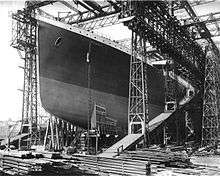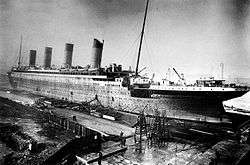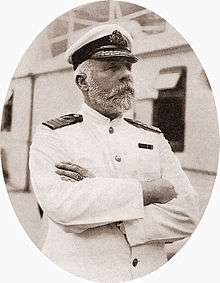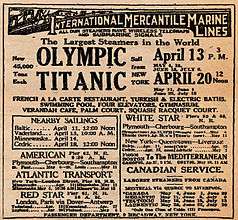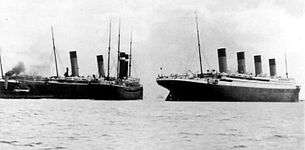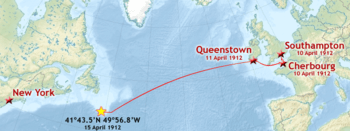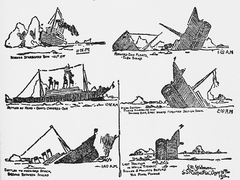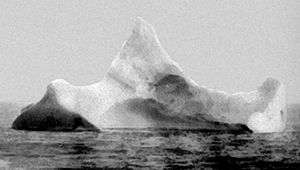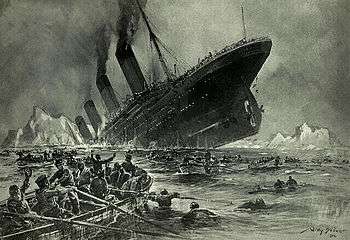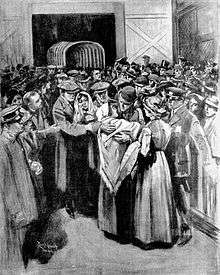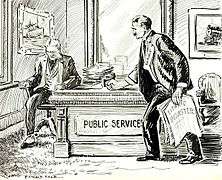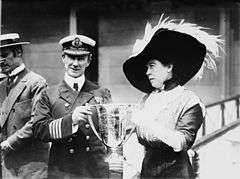RMS Titanic
 RMS Titanic departing Southampton on 10 April 1912 | |
| History | |
|---|---|
| Name: | RMS Titanic |
| Owner: |
|
| Port of registry: |
|
| Route: | Southampton to New York City |
| Ordered: | 17 September 1908 |
| Builder: | Harland and Wolff, Belfast |
| Cost: | 7.5 million (US dollars) |
| Yard number: | 401 |
| Laid down: | 31 March 1909 |
| Launched: | 31 May 1911 |
| Completed: | 2 April 1912 |
| Maiden voyage: | 10 April 1912 |
| In service: | 10–15 April 1912 |
| Identification: | Radio call sign "MGY" |
| Fate: | Hit an iceberg 11:40 p.m. (ship's time) 14 April 1912 on her maiden voyage and sank 2 h 40 min later |
| Status: | Wreck |
| General characteristics | |
| Class and type: | Olympic-class ocean liner |
| Tonnage: | 46,328 GRT |
| Displacement: | 52,310 tons |
| Length: | 882 ft 9 in (269.1 m) |
| Beam: | 92 ft 6 in (28.2 m) |
| Height: | 175 ft (53.3 m) (keel to top of funnels) |
| Draught: | 34 ft 7 in (10.5 m) |
| Depth: | 64 ft 6 in (19.7 m) |
| Decks: | 9 (A–G) |
| Installed power: | 24 double-ended and five single-ended boilers feeding two reciprocating steam engines for the wing propellers, and a low-pressure turbine for the centre propeller;[1] output: 46,000 HP |
| Propulsion: | Two three-blade wing propellers and one four-blade centre propeller |
| Speed: | Cruising: 21 kn (39 km/h; 24 mph). Max: 24 kn (44 km/h; 28 mph) |
| Capacity: | Passengers: 2,435, crew: 892. Total: 3,327 (or 3,547 according to other sources) |
| Notes: | Lifeboats: 20 (sufficient for 1,178 people) |
RMS Titanic (/taɪˈtænɪk/) was a British passenger liner that sank in the North Atlantic Ocean in the early morning of 15 April 1912, after colliding with an iceberg during her maiden voyage from Southampton to New York City. Of the 2,224 passengers and crew aboard, more than 1,500 died, making it one of the deadliest commercial peacetime maritime disasters in modern history. The largest ship afloat at the time it entered service, the RMS Titanic was the second of three Olympic class ocean liners operated by the White Star Line, and was built by the Harland and Wolff shipyard in Belfast. Thomas Andrews, her architect, died in the disaster.
Under the command of Edward Smith, who went down with the ship, Titanic carried some of the wealthiest people in the world, as well as hundreds of emigrants from Great Britain and Ireland, Scandinavia and elsewhere throughout Europe seeking a new life in North America. A high-power radiotelegraph transmitter was available for sending passenger "marconigrams" and for the ship's operational use. Although Titanic had advanced safety features such as watertight compartments and remotely activated watertight doors, there were not enough lifeboats to accommodate all of those aboard due to outdated maritime safety regulations. Titanic only carried enough lifeboats for 1,178 people—slightly more than half of the number on board, and one third of her total capacity.
After leaving Southampton on 10 April 1912, Titanic called at Cherbourg in France and Queenstown (now Cobh) in Ireland before heading west to New York.[2] On 14 April, four days into the crossing and about 375 miles (600 km) south of Newfoundland, she hit an iceberg at 11:40 p.m. ship's time. The collision caused the ship's hull plates to buckle inwards along her starboard side and opened five of her sixteen watertight compartments to the sea; the ship gradually filled with water. Meanwhile, passengers and some crew members were evacuated in lifeboats, many of which were launched only partially loaded. A disproportionate number of men were left aboard because of a "women and children first" protocol for loading lifeboats.[3] At 2:20 a.m., she broke apart and foundered—with well over one thousand people still aboard. Just under two hours after Titanic sank, the Cunard liner RMS Carpathia arrived at the scene, where she brought aboard an estimated 705 survivors.
The disaster was greeted with worldwide shock and outrage at the huge loss of life and the regulatory and operational failures that had led to it. Public inquiries in Britain and the United States led to major improvements in maritime safety. One of their most important legacies was the establishment in 1914 of the International Convention for the Safety of Life at Sea (SOLAS), which still governs maritime safety today. Additionally, several new wireless regulations were passed around the world in an effort to learn from the many missteps in wireless communications—which could have saved many more passengers.[4]
The wreck of Titanic, first discovered over 70 years after the sinking, remains on the seabed, split in two and gradually disintegrating at a depth of 12,415 feet (3,784 m). Since her discovery in 1985, thousands of artefacts have been recovered and put on display at museums around the world. Titanic has become one of the most famous ships in history; her memory is kept alive by numerous works of popular culture, including books, folk songs, films, exhibits, and memorials.
Background
The name Titanic was derived from Greek mythology and meant gigantic. Built in Belfast, Ireland, in the United Kingdom of Great Britain and Ireland (as it was then known), the RMS Titanic was the second of the three Olympic-class ocean liners—the first was the RMS Olympic and the third was the HMHS Britannic.[5] They were by far the largest vessels of the British shipping company White Star Line's fleet, which comprised 29 steamers and tenders in 1912.[6] The three ships had their genesis in a discussion in mid-1907 between the White Star Line's chairman, J. Bruce Ismay, and the American financier J. P. Morgan, who controlled the White Star Line's parent corporation, the International Mercantile Marine Co. (IMM).
The White Star Line faced an increasing challenge from its main rivals Cunard, which had recently launched the Lusitania and the Mauretania—the fastest passenger ships then in service—and the German lines Hamburg America and Norddeutscher Lloyd. Ismay preferred to compete on size rather than speed and proposed to commission a new class of liners that would be larger than anything that had gone before as well as being the last word in comfort and luxury.[7] The company sought an upgrade in their fleet primarily in response to the Cunard giants but also to replace their oldest pair of passenger ships still in service, being the SS Teutonic of 1889 and SS Majestic of 1890. Teutonic was replaced by Olympic while Majestic was replaced by Titanic. Majestic would be brought back into her old spot on White Star's New York service after Titanic's loss.[8]
The ships were constructed by the Belfast shipbuilders Harland and Wolff, who had a long-established relationship with the White Star Line dating back to 1867.[9] Harland and Wolff were given a great deal of latitude in designing ships for the White Star Line; the usual approach was for the latter to sketch out a general concept which the former would take away and turn into a ship design. Cost considerations were relatively low on the agenda and Harland and Wolff was authorised to spend what it needed on the ships, plus a five percent profit margin.[9] In the case of the Olympic-class ships, a cost of £3 million for the first two ships was agreed plus "extras to contract" and the usual five percent fee.[10]
Harland and Wolff put their leading designers to work designing the Olympic-class vessels. The design was overseen by Lord Pirrie, a director of both Harland and Wolff and the White Star Line; naval architect Thomas Andrews, the managing director of Harland and Wolff's design department; Edward Wilding, Andrews' deputy and responsible for calculating the ship's design, stability and trim; and Alexander Carlisle, the shipyard's chief draughtsman and general manager.[11] Carlisle's responsibilities included the decorations, equipment and all general arrangements, including the implementation of an efficient lifeboat davit design.[lower-alpha 1]
On 29 July 1908, Harland and Wolff presented the drawings to J. Bruce Ismay and other White Star Line executives. Ismay approved the design and signed three "letters of agreement" two days later authorising the start of construction.[14] At this point the first ship—which was later to become Olympic—had no name, but was referred to simply as "Number 400", as it was Harland and Wolff's four hundredth hull. Titanic was based on a revised version of the same design and was given the number 401.[15]
Dimensions and layout

Titanic was 882 feet 9 inches (269.06 m) long with a maximum breadth of 92 feet 6 inches (28.19 m). Her total height, measured from the base of the keel to the top of the bridge, was 104 feet (32 m).[16] She measured 46,328 gross register tons and with a draught of 34 feet 7 inches (10.54 m), she displaced 52,310 tons.[17]
All three of the Olympic-class ships had ten decks (excluding the top of the officers' quarters), eight of which were for passenger use. From top to bottom, the decks were:
- The Boat Deck, on which the lifeboats were housed. It was from here during the early hours of 15 April 1912 that Titanic's lifeboats were lowered into the North Atlantic. The bridge and wheelhouse were at the forward end, in front of the captain's and officers' quarters. The bridge stood 8 feet (2.4 m) above the deck, extending out to either side so that the ship could be controlled while docking. The wheelhouse stood directly behind and above the bridge. The entrance to the First Class Grand Staircase and gymnasium were located midships along with the raised roof of the First Class lounge, while at the rear of the deck were the roof of the First Class smoke room and the relatively modest Second Class entrance. The wood-covered deck was divided into four segregated promenades: for officers, First Class passengers, engineers, and Second Class passengers respectively. Lifeboats lined the side of the deck except in the First Class area, where there was a gap so that the view would not be spoiled.[18][19]
- A Deck, also called the Promenade Deck, extended along the entire 546 feet (166 m) length of the superstructure. It was reserved exclusively for First Class passengers and contained First Class cabins, the First Class lounge, smoke room, reading and writing rooms and Palm Court.[18]
- B Deck, the Bridge Deck, was the top weight-bearing deck and the uppermost level of the hull. More First Class passenger accommodation was located here with six palatial staterooms (cabins) featuring their own private promenades. On Titanic, the A La Carte Restaurant and the Café Parisien provided luxury dining facilities to First Class passengers. Both were run by subcontracted chefs and their staff; all were lost in the disaster. The Second Class smoking room and entrance hall were both located on this deck. The raised forecastle of the ship was forward of the Bridge Deck, accommodating Number 1 hatch (the main hatch through to the cargo holds), numerous pieces of machinery and the anchor housings.[lower-alpha 2] Aft of the Bridge Deck was the raised Poop Deck, 106 feet (32 m) long, used as a promenade by Third Class passengers. It was where many of Titanic's passengers and crew made their last stand as the ship sank. The forecastle and Poop Deck were separated from the Bridge Deck by well decks.[20][21]
- C Deck, the Shelter Deck, was the highest deck to run uninterrupted from stem to stern. It included both well decks; the aft one served as part of the Third Class promenade. Crew cabins were housed below the forecastle and Third Class public rooms were housed below the Poop Deck. In between were the majority of First Class cabins and the Second Class library.[20][22]
- D Deck, the Saloon Deck, was dominated by three large public rooms—the First Class Reception Room, the First Class Dining Saloon and the Second Class Dining Saloon. An open space was provided for Third Class passengers. First, Second and Third Class passengers had cabins on this deck, with berths for firemen located in the bow. It was the highest level reached by the ship's watertight bulkheads (though only by eight of the fifteen bulkheads).[20][23]
- E Deck, the Upper Deck, was predominantly used for passenger accommodation for all three classes plus berths for cooks, seamen, stewards and trimmers. Along its length ran a long passageway nicknamed Scotland Road, in reference to a famous street in Liverpool. Scotland Road was used by Third Class passengers and crew members.[20][24]
- F Deck, the Middle Deck, was the last complete deck and mainly accommodated Second and Third Class passengers and several departments of the crew. The Third Class dining saloon was located here, as were the swimming pool and Turkish bath.[20][24]
- G Deck, the Lower Deck, was the lowest complete deck that carried passengers, and had the lowest portholes, just above the waterline. The squash court was located here along with the travelling post office where letters and parcels were sorted ready for delivery when the ship docked. Food was also stored here. The deck was interrupted at several points by orlop (partial) decks over the boiler, engine and turbine rooms.[20][25]
- The Orlop Decks and the Tank Top below that were on the lowest level of the ship, below the waterline. The orlop decks were used as cargo spaces, while the Tank Top—the inner bottom of the ship's hull—provided the platform on which the ship's boilers, engines, turbines and electrical generators were housed. This area of the ship was occupied by the engine and boiler rooms, areas which passengers would have been prohibited from seeing. They were connected with higher levels of the ship by flights of stairs; twin spiral stairways near the bow provided access up to D Deck.[20][25]
Features
Power
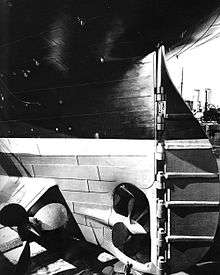
Titanic was equipped with three main engines—two reciprocating four-cylinder, triple-expansion steam engines and one centrally placed low-pressure Parsons turbine—each driving a propeller. The two reciprocating engines had a combined output of 30,000 hp and a further 16,000 hp was contributed by the turbine.[16] The White Star Line had used the same combination of engines on an earlier liner, the SS Laurentic, where it had been a great success.[27] It provided a good combination of performance and speed; reciprocating engines by themselves were not powerful enough to propel an Olympic-class liner at the desired speeds, while turbines were sufficiently powerful but caused uncomfortable vibrations, a problem that affected the all-turbine Cunard liners Lusitania and Mauretania.[28] By combining reciprocating engines with a turbine, fuel usage could be reduced and motive power increased, while using the same amount of steam.[29]
The two reciprocating engines were each 63 feet (19 m) long and weighed 720 tons, with their bedplates contributing a further 195 tons.[28] They were powered by steam produced in 29 boilers, 24 of which were double-ended and five single-ended, which contained a total of 159 furnaces.[30] The boilers were 15 feet 9 inches (4.80 m) in diameter and 20 feet (6.1 m) long, each weighing 91.5 tons and capable of holding 48.5 tons of water.[31]
They were heated by burning coal, 6,611 tons of which could be carried in Titanic's bunkers with a further 1,092 tons in Hold 3. The furnaces required over 600 tons of coal a day to be shovelled into them by hand, requiring the services of 176 firemen working around the clock.[32] 100 tons of ash a day had to be disposed of by ejecting it into the sea.[33] The work was relentless, dirty and dangerous, and although firemen were paid relatively generously[32] there was a high suicide rate among those who worked in that capacity.[34]
Exhaust steam leaving the reciprocating engines was fed into the turbine, which was situated aft. From there it passed into a condenser, to increase the efficiency of the turbine and so that the steam could be condensed back into water and reused.[35] The engines were attached directly to long shafts which drove the propellers. There were three, one for each engine; the outer (or wing) propellers were the largest, each carrying three blades of manganese-bronze alloy with a total diameter of 23.5 feet (7.2 m).[31] The middle propeller was slightly smaller at 17 feet (5.2 m) in diameter,[36] and could be stopped but not reversed.
Titanic's electrical plant was capable of producing more power than an average city power station of the time.[37] Immediately aft of the turbine engine were four 400 kW steam-driven electric generators, used to provide electrical power to the ship, plus two 30 kW auxiliary generators for emergency use.[38] Their location in the stern of the ship meant that they remained operational until the last few minutes before the ship sank.[39]
Technology
Watertight compartments and funnels
The interiors of the Olympic-class ships were subdivided into 16 primary compartments divided by 15 bulkheads which extended well above the waterline. Eleven vertically closing watertight doors could seal off the compartments in the event of an emergency.[40] The ship's exposed decking was made of pine and teak, while interior ceilings were covered in painted granulated cork to combat condensation.[41] Standing above the decks were four funnels, each painted buff with black tops, (though only three were functional—the last one was a dummy, installed for aesthetic purposes and also for kitchen ventilation)—and two masts, each 155 feet (47 m) high, which supported derricks for working cargo.
Rudder and steering engines
Titanic's rudder was large enough—at 78 feet 8 inches (23.98 m) high and 15 feet 3 inches (4.65 m) long, weighing over 100 tons—that it required steering engines to move it. Two steam-powered steering engines were installed though only one was used at any one time, with the other one kept in reserve. They were connected to the short tiller through stiff springs, to isolate the steering engines from any shocks in heavy seas or during fast changes of direction.[42] As a last resort, the tiller could be moved by ropes connected to two steam capstans.[43] The capstans were also used to raise and lower the ship's five anchors (one port, one starboard, one in the centreline and two kedging anchors).[43]
Water, ventilation and heating
The ship was equipped with her own waterworks, capable of heating and pumping water to all parts of the vessel via a complex network of pipes and valves. The main water supply was taken aboard while Titanic was in port, but in an emergency the ship could also distil fresh water from seawater, though this was not a straightforward process as the distillation plant quickly became clogged by salt deposits. A network of insulated ducts conveyed warm air, driven by electric fans, around the ship, and First Class cabins were fitted with additional electric heaters.[37]
Radio communications
Titanic's radiotelegraph equipment (then known as wireless telegraphy) was leased to the White Star Line by the Marconi International Marine Communication Company, which also supplied two of its employees, Jack Phillips and Harold Bride, as operators. The service maintained a 24-hour schedule, primarily sending and receiving passenger telegrams, but also handling navigation messages including weather reports and ice warnings.[44][45]
The radio room was located on the Boat Deck, in the officers' quarters. A soundproofed "Silent Room", next to the operating room, housed loud equipment, including the transmitter and a motor-generator used for producing alternating currents. The operators' living quarters were adjacent to the working office. The ship was equipped with a 'state of the art' 5 kilowatt rotary spark-gap transmitter, operating under the radio callsign MGY, and communication was conducted in Morse code. This transmitter was one of the first Marconi installations to use a rotary spark gap, which gave Titanic a distinctive musical tone that could be readily distinguished from other signals. The transmitter was one of the most powerful in the world, and guaranteed to broadcast over a radius of 350 miles (563 km). An elevated T-antenna that spanned the length of the ship was used for transmitting and receiving. The normal operating frequency was 500 kHz (600 m wavelength), however the equipment could also operate on the "short" wavelength of 1000 kHz (300 m wavelength) that was employed by smaller vessels with shorter antennas.[46]
Passenger facilities
The passenger facilities aboard Titanic aimed to meet the highest standards of luxury. According to Titanic's general arrangement plans, the ship could accommodate 833 First Class Passengers, 614 in Second Class and 1,006 in Third Class, for a total passenger capacity of 2,453. In addition, her capacity for crew members exceeded 900, as most documents of her original configuration have stated that her full carrying capacity for both passengers and crew was approximately 3,547. Her interior design was a departure from that of other passenger liners, which had typically been decorated in the rather heavy style of a manor house or an English country house.[47]
Titanic was laid out in a much lighter style similar to that of contemporary high-class hotels—the Ritz Hotel was a reference point—with First Class cabins finished in the Empire style.[47] A variety of other decorative styles, ranging from the Renaissance to Victorian, were used to decorate cabins and public rooms in First and Second Class areas of the ship. The aim was to convey an impression that the passengers were in a floating hotel rather than a ship; as one passenger recalled, on entering the ship's interior a passenger would "at once lose the feeling that we are on board ship, and seem instead to be entering the hall of some great house on shore".[48]
Passengers could use an on-board telephone system, a lending library and a large barber shop.[49] The First Class section had a swimming pool, a gymnasium, a squash court, a Turkish bath, an electric bath and a Verandah Cafe.[48] First Class common rooms were adorned with ornate wood panelling, expensive furniture and other decorations, while the Third Class general room had pine panelling and sturdy teak furniture.[50] The Café Parisien was located on a sunlit veranda fitted with trellis decorations and offered the best French haute cuisine for First Class passengers.[51]
Third Class (also commonly referred to as Steerage) accommodations aboard Titanic were not as luxurious as First Class, but even so were better than on many other ships of the time. They reflected the improved standards which the White Star Line had adopted for trans-Atlantic immigrant and lower-class travel. On most other North Atlantic passenger ships at the time, Third Class accommodations consisted of little more than open dormitories in the forward end of the vessels, in which hundreds of people were confined, often without adequate food or toilet facilities.
The White Star Line had long since broken that mould. As seen aboard Titanic, all White Star Line passenger ships divided their Third Class accommodations into two sections, always at opposite ends of the vessel from one another. The established arrangement was that single men were quartered in the forward areas, while single women, married couples and families were quartered aft. In addition, while other ships provided only open berth sleeping arrangements, White Star Line vessels provided their Third Class passengers with private, small but comfortable cabins capable of accommodating two, four, six, eight and 10 passengers.
Third Class accommodations also included their own dining rooms, as well as public gathering areas including adequate open deck space, which aboard Titanic included the Forecastle Deck forward, the Poop Deck aft, both well decks and a large open space on D Deck which could be used as a social hall. This was supplemented by the addition of a smoking room for men and a reading room for women, and although they were not as glamorous in design as spaces seen in upper class accommodations, they were still far above average for the period.
Leisure facilities were provided for all three classes to pass the time. As well as making use of the indoor amenities such as the library, smoking rooms, and gymnasium, it was also customary for passengers to socialise on the open deck, promenading or relaxing in hired deck chairs or wooden benches. A passenger list was published before the sailing to inform the public which members of the great and good were on board, and it was not uncommon for ambitious mothers to use the list to identify rich bachelors to whom they could introduce their marriageable daughters during the voyage.[52]
One of Titanic's most distinctive features was her First Class staircase, known as the Grand Staircase or Grand Stairway. This descended through seven decks of the ship, from the Boat Deck to E deck in the elegant style depicted in photographs and movies, and then as a more functional and less elegant staircase from there down to F deck.[53] It was capped with a dome of wrought iron and glass that admitted natural light. Each landing off the staircase gave access to ornate entrance halls lit by gold-plated light fixtures.[54]
At the uppermost landing was a large carved wooden panel containing a clock, with figures of "Honour and Glory Crowning Time" flanking the clock face.[53] The Grand Staircase was destroyed in Titanic's sinking and is now just a void in the ship which modern explorers have used to access the lower decks.[55] During the filming of James Cameron's Titanic in 1997, his replica of the Grand Staircase was ripped from its foundations by the force of the inrushing water on the set. It has been suggested that during the real event, the entire Grand Staircase was ejected upwards through the dome.[56]


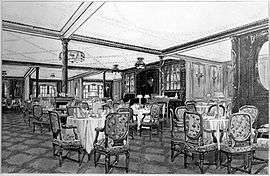
Mail and cargo
Although Titanic was primarily a passenger liner, she also carried a substantial amount of cargo. Her designation as a Royal Mail Ship (RMS) indicated that she carried mail under contract with the Royal Mail (and also for the United States Post Office Department). For the storage of letters, parcels and specie (bullion, coins and other valuables) 26,800 cubic feet (760 m3) of space in her holds was allocated. The Sea Post Office on G Deck was manned by five postal clerks; three Americans and two Britons, who worked 13 hours a day, seven days a week sorting up to 60,000 items daily.[58]
The ship's passengers brought with them a huge amount of baggage; another 19,455 cubic feet (550.9 m3) was taken up by first- and second-class baggage. In addition, there was a considerable quantity of regular cargo, ranging from furniture to foodstuffs and even motor cars.[58] Despite later myths, the cargo on Titanic's maiden voyage was fairly mundane; there was no gold, exotic minerals or diamonds, and one of the more famous items lost in the shipwreck, a jewelled copy of the Rubaiyat of Omar Khayyam, was valued at only £405 (£36,162 today).[59] According to the claims for compensation filed with Commissioner Gilchrist, following the conclusion of the Senate Inquiry, the single most highly valued item of luggage or cargo was a large neoclassical oil painting entitled La Circassienne au Bain by French artist Merry-Joseph Blondel. The painting’s owner, first class passenger Mauritz Håkan Björnström-Steffansson, filed a claim for $100,000 ($2.4 million equivalent in 2014) in compensation for the loss of the artwork.[57]
Titanic was equipped with eight electric cranes, four electric winches and three steam winches to lift cargo and baggage in and out of the hold. It is estimated that the ship used some 415 tons of coal whilst in Southampton, simply generating steam to operate the cargo winches and provide heat and light.[60]
Lifeboats

Titanic carried a total of 20 lifeboats: 14 standard wooden Harland and Wolff lifeboats with a capacity of 65 people each and four Englehardt "collapsible" (wooden bottom, collapsible canvas sides) lifeboats (identified as A to D) with a capacity of 47 people each. In addition, she had two emergency cutters with a capacity of 40 people each.[61][lower-alpha 5] Olympic herself did not even carry the four collapsibles A–D during the 1911–12 season. All of the lifeboats were stowed securely on the boat deck and, except for collapsible lifeboats A and B, connected to davits by ropes. Those on the starboard side were odd-numbered 1–15 from bow to stern, while those on the port side were even-numbered 2–16 from bow to stern.[62]
Both cutters were kept swung out, hanging from the davits, ready for immediate use, while collapsible lifeboats C and D were stowed on the boat deck (connected to davits) immediately inboard of boats 1 and 2 respectively. A and B were stored on the roof of the officers' quarters, on either side of number 1 funnel. There were no davits to lower them and their weight would make them difficult to launch by hand.[62] Each boat carried (among other things) food, water, blankets, and a spare life belt. Lifeline ropes on the boats' sides enabled them to save additional people from the water if necessary.
Titanic had 16 sets of davits, each able to handle four lifeboats. This gave Titanic the ability to carry up to 64 wooden lifeboats[63] which would have been enough for 4,000 people—considerably more than her actual capacity. However, the White Star Line decided that only 16 wooden lifeboats and four collapsibles would be carried, which could accommodate 1,178 people, only one-third of Titanic's total capacity. At the time, the Board of Trade's regulations required British vessels over 10,000 tons to only carry 16 lifeboats with a capacity of 990 occupants.[61]
Therefore, the White Star Line actually provided more lifeboat accommodation than was legally required.[64][lower-alpha 6] At the time, lifeboats were intended to ferry survivors from a sinking ship to a rescuing ship—not keep afloat the whole population or power them to shore. Had the SS Californian responded to Titanic's distress calls, the lifeboats may have been adequate to ferry the passengers to safety as planned.[66]
Building and preparing the ship
Construction, launch and fitting-out
.webm.jpg)
The sheer size of Titanic and her sister ships posed a major engineering challenge for Harland and Wolff; no shipbuilder had ever before attempted to construct vessels this size. The ships were constructed on Queen's Island, now known as the Titanic Quarter, in Belfast Harbour. Harland and Wolff had to demolish three existing slipways and build two new ones, the largest ever constructed up to that time, to accommodate both ships.[10] Their construction was facilitated by an enormous gantry built by Sir William Arrol & Co., a Scottish firm responsible for the building of the Forth Bridge and London's Tower Bridge. The Arrol Gantry stood 228 feet (69 m) high, was 270 feet (82 m) wide and 840 feet (260 m) long, and weighed more than 6,000 tons. It accommodated a number of mobile cranes. A separate floating crane, capable of lifting 200 tons, was brought in from Germany.[67]
The construction of Olympic and Titanic took place virtually in parallel, with Olympic's keel laid down first on 16 December 1908 and Titanic's on 31 March 1909.[15] Both ships took about 26 months to build and followed much the same construction process. They were designed essentially as an enormous floating box girder, with the keel acting as a backbone and the frames of the hull forming the ribs. At the base of the ships, a double bottom 5 feet 3 inches (1.60 m) deep supported 300 frames, each between 24 inches (61 cm) and 36 inches (91 cm) apart and measuring up to about 66 feet (20 m) long. They terminated at the bridge deck (B Deck) and were covered with steel plates which formed the outer skin of the ships.[68]
The 2,000 hull plates were single pieces of rolled steel plate, mostly up to 6 feet (1.8 m) wide and 30 feet (9.1 m) long and weighing between 2.5 and 3 tons.[69] Their thickness varied from 1 inch (2.5 cm) to 1.5 inches (3.8 cm).[40] The plates were laid in a clinkered (overlapping) fashion from the keel to the bilge. Above that point they were laid in the "in and out" fashion, where strake plating was applied in bands (the "in strakes") with the gaps covered by the "out strakes", overlapping on the edges. Commercial oxy-fuel and electric arc welding methods, ubiquitous in fabrication today, were still in their infancy; like most other iron and steel structures of the era, the hull was held together with over three million iron and steel rivets, which by themselves weighed over 1,200 tons. They were fitted using hydraulic machines or were hammered in by hand.[70] In the 1990s some material scientists concluded[71] that the steel plate used for the ship was subject to being especially brittle when cold, and that this brittleness exacerbated the impact damage and hastened the sinking. It is believed that, by the standards of the time, the steel plate's quality was good, not faulty, but that it was inferior to what would be used for shipbuilding purposes in later decades, owing to advances in the metallurgy of steelmaking.[71] As for the rivets, considerable emphasis has also been placed on their quality and strength.[72][73][74][75][76]
One of the last items to be fitted on Titanic before the ship's launch was her two side anchors and one centre anchor. The anchors themselves were a challenge to make with the centre anchor being the largest ever forged by hand and weighing nearly 16 tons. Twenty Clydesdale draught horses were needed to haul the centre anchor by wagon from the Noah Hingley & Sons Ltd forge shop in Netherton, near Dudley, United Kingdom to the Dudley railway station two miles away. From there it was shipped by rail to Fleetwood in Lancashire before being loaded aboard a ship and sent to Belfast.[77]
The work of constructing the ships was difficult and dangerous. For the 15,000 men who worked at Harland and Wolff at the time,[78] safety precautions were rudimentary at best; a lot of the work was dangerous and was carried out without any safety equipment like hard hats or hand guards on machinery. As a result, deaths and injuries were to be expected. During Titanic's construction, 246 injuries were recorded, 28 of them "severe", such as arms severed by machines or legs crushed under falling pieces of steel. Six people died on the ship herself while she was being constructed and fitted out, and another two died in the shipyard workshops and sheds.[79] Just before the launch a worker was killed when a piece of wood fell on him.[80]
Titanic was launched at 12:15 p.m. on 31 May 1911 in the presence of Lord Pirrie, J. Pierpoint Morgan, J. Bruce Ismay and 100,000 onlookers.[81] 22 tons of soap and tallow were spread on the slipway to lubricate the ship's passage into the River Lagan.[80] In keeping with the White Star Line's traditional policy, the ship was not formally named or christened with champagne.[81] The ship was towed to a fitting-out berth where, over the course of the next year, her engines, funnels and superstructure were installed and her interior was fitted out.[82]
Although Titanic was virtually identical to the class's lead ship Olympic, a few changes were made to distinguish both ships. The most noticeable of these was that Titanic (and the third vessel in class Britannic) had a steel screen with sliding windows installed along the forward half of the A Deck promenade. This was installed as a last minute change at the personal request of Bruce Ismay, and was intended to provide additional shelter to first class passengers.[83] These changes made Titanic slightly heavier than her sister, and thus she could claim to be the largest ship afloat. The work took longer than expected due to design changes requested by Ismay and a temporary pause in work occasioned by the need to repair Olympic, which had been in a collision in September 1911. Had Titanic been finished earlier, she might well have missed her collision with an iceberg.[80]
|
Sea trials
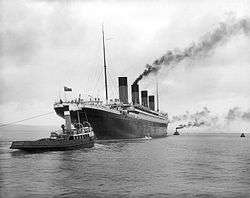
Titanic's sea trials began at 6 a.m. on Tuesday, 2 April 1912, just two days after her fitting out was finished and eight days before she was due to leave Southampton on her maiden voyage.[84] The trials were delayed for a day due to bad weather, but by Monday morning it was clear and fair.[85] Aboard were 78 stokers, greasers and firemen, and 41 members of crew. No domestic staff appear to have been aboard. Representatives of various companies travelled on Titanic's sea trials, Thomas Andrews and Edward Wilding of Harland and Wolff and Harold A. Sanderson of IMM. Bruce Ismay and Lord Pirrie were too ill to attend. Jack Phillips and Harold Bride served as radio operators, and performed fine-tuning of the Marconi equipment. Francis Carruthers, a surveyor from the Board of Trade, was also present to see that everything worked, and that the ship was fit to carry passengers.[86]
The sea trials consisted of a number of tests of her handling characteristics, carried out first in Belfast Lough and then in the open waters of the Irish Sea. Over the course of about 12 hours, Titanic was driven at different speeds, her turning ability was tested and a "crash stop" was performed in which the engines were reversed full ahead to full astern, bringing her to a stop in 850 yd (777 m) or 3 minutes and 15 seconds.[87] The ship covered a distance of about 80 nautical miles (92 mi; 150 km), averaging 18 knots (21 mph; 33 km/h) and reaching a maximum speed of just under 21 knots (24 mph; 39 km/h).[88]
On returning to Belfast at about 7 p.m., the surveyor signed an "Agreement and Account of Voyages and Crew", valid for 12 months, which declared the ship seaworthy. An hour later, Titanic left Belfast again—as it turned out, for the last time—to head to Southampton, a voyage of about 570 nautical miles (660 mi; 1,060 km). After a journey lasting about 28 hours she arrived about midnight on 4 April and was towed to the port's Berth 44, ready for the arrival of her passengers and the remainder of her crew.[89]
Maiden voyage
Both Olympic and Titanic registered Liverpool as their home port. The offices of the White Star Line as well as Cunard were in Liverpool, and up until the introduction of the Olympic, most British ocean liners for both Cunard and White Star, such as Lusitania and Mauretania, sailed out of Liverpool followed by a port of call in Queenstown, Ireland. Since the company's founding in 1871, a vast majority of their operations had taken place out of Liverpool. However, in 1907 White Star established another service out of the port of Southampton on England's south coast, which became known as White Star's "Express Service". Southampton had many advantages over Liverpool, the first being its closer proximity to London.[90]
In addition, Southampton, being on the south coast, allowed ships to easily cross the English Channel and make a port of call on the northern coast of France, usually at Cherbourg. This allowed British ships to pick up clientele from continental Europe before recrossing the channel and picking up passengers at Queenstown. The Southampton-Cherbourg-New York run would become so popular that most British ocean liners began using the port after World War I. Out of respect for Liverpool, ships continued to be registered there until the early 1960s. Queen Elizabeth 2 was one of the first ships registered in Southampton when introduced into service by Cunard in 1969.[90]
Titanic's maiden voyage was intended to be the first of many Trans-Atlantic crossings between Southampton and New York via Cherbourg and Queenstown on westbound runs, returning via Plymouth in England while eastbound. Indeed, her entire schedule of voyages through to December 1912 still exists.[91] When the route was established, four ships were assigned to the service. In addition to Teutonic and Majestic, the RMS Oceanic and the brand new RMS Adriatic sailed the route. When the Olympic entered service in June 1911, she replaced Teutonic, which after completing her last run on the service in late April was transferred to the Dominion Line's Canadian service. The following August, Adriatic was transferred to White Star's main Liverpool-New York service, and in November, Majestic was withdrawn from service impending the arrival of Titanic in the coming months, and was mothballed as a reserve ship.[92][93]
White Star's initial plans for Olympic and Titanic on the Southampton run followed the same routine as their predecessors had done before them. Each would sail once every three weeks from Southampton and New York usually leaving at noon each Wednesday from Southampton and each Saturday from New York, thus enabling the White Star Line to offer weekly sailings in each direction. Special trains were scheduled from London and Paris to convey passengers to Southampton and Cherbourg respectively.[93] The deep-water dock at Southampton, then known as the "White Star Dock", had been specially constructed to accommodate the new Olympic-class liners, and had opened in 1911.[94]
|
Crew
Titanic had around 885 crew members on board for her maiden voyage.[95] Like other vessels of her time, she did not have a permanent crew, and the vast majority of crew members were casual workers who only came aboard the ship a few hours before she sailed from Southampton.[96] The process of signing up recruits had begun on 23 March and some had been sent to Belfast, where they served as a skeleton crew during Titanic's sea trials and passage to England at the start of April.[97]
Captain Edward John Smith, the most senior of the White Star Line's captains, was transferred from Olympic to take command of Titanic.[98] Henry Tingle Wilde also came across from Olympic to take the post of Chief Mate. Titanic's previously designated Chief Mate and First Officer, William McMaster Murdoch and Charles Lightoller, were bumped down to the ranks of First and Second Officer respectively. The original Second Officer, David Blair, was dropped altogether.[99][lower-alpha 7] The Third Officer was Herbert Pitman MBE, the only deck officer who was not a member of the Royal Naval Reserve. Pitman was the second to last surviving officer.
Titanic's crew were divided into three principal departments: Deck, with 66 crew; Engine, with 325; and Victualling (pronounced vi-tal-ling), with 494.[100] The vast majority of the crew were thus not seamen, but were either engineers, firemen, or stokers, responsible for looking after the engines, or stewards and galley staff, responsible for the passengers.[101] Of these, over 97% were male; just 23 of the crew were female, mainly stewardesses.[102] The rest represented a great variety of professions—bakers, chefs, butchers, fishmongers, dishwashers, stewards, gymnasium instructors, laundrymen, waiters, bed-makers, cleaners, and even a printer,[102] who produced a daily newspaper for passengers called the Atlantic Daily Bulletin with the latest news received by the ship's wireless operators.[44][lower-alpha 8]
Most of the crew signed on in Southampton on 6 April;[15] in all, 699 of the crew came from there, and 40% were natives of the town.[102] A few specialist staff were self-employed or were subcontractors. These included the five postal clerks, who worked for the Royal Mail and the United States Post Office Department, the staff of the First Class A La Carte Restaurant and the Café Parisien, the radio operators (who were employed by Marconi) and the eight musicians, who were employed by an agency and travelled as second-class passengers.[104] Crew pay varied greatly, from Captain Smith's £105 a month (equivalent to £9,375 today) to the £3 10s (£313 today) that stewardesses earned. The lower-paid victualling staff could, however, supplement their wages substantially through tips from passengers.[103]
Passengers

Titanic's passengers numbered approximately 1,317 people: 324 in First Class, 284 in Second Class, and 709 in Third Class. Of these, 869 (66%) were male and 447 (34%) female. There were 107 children aboard, the largest number of which were in Third Class.[105] The ship was considerably under capacity on her maiden voyage, as she could accommodate 2,453 passengers—833 First Class, 614 Second Class, and 1,006 Third Class.[106]
Usually, a high prestige vessel like Titanic could expect to be fully booked on its maiden voyage. However, a national coal strike in the UK had caused considerable disruption to shipping schedules in the spring of 1912, causing many crossings to be cancelled. Many would-be passengers chose to postpone their travel plans until the strike was over. The strike had finished a few days before Titanic sailed; however, that was too late to have much of an effect. Titanic was able to sail on the scheduled date only because coal was transferred from other vessels which were tied up at Southampton, such as SS City of New York and RMS Oceanic, as well as coal Olympic had brought back from a previous voyage to New York, which had been stored at the White Star Dock.[83]
Some of the most prominent people of the day booked a passage aboard Titanic, travelling in First Class. Among them were the American millionaire John Jacob Astor IV and his wife Madeleine Force Astor, industrialist Benjamin Guggenheim, Macy's owner Isidor Straus and his wife Ida, Denver millionairess Margaret "Molly" Brown,[lower-alpha 9] Sir Cosmo Duff Gordon and his wife, couturière Lucy (Lady Duff-Gordon), cricketer and businessman John Borland Thayer with his wife Marian and son Jack, the Countess of Rothes, author and socialite Helen Churchill Candee, journalist and social reformer William Thomas Stead, author Jacques Futrelle with his wife May, and silent film actress Dorothy Gibson, among others.[107] Titanic's owner J. P. Morgan was scheduled to travel on the maiden voyage but cancelled at the last minute.[108] Also aboard the ship were the White Star Line's managing director J. Bruce Ismay and Titanic's designer Thomas Andrews, who was on board to observe any problems and assess the general performance of the new ship.[109]
The exact number of people aboard is not known, as not all of those who had booked tickets made it to the ship; about 50 people cancelled for various reasons,[110] and not all of those who boarded stayed aboard for the entire journey.[111] Fares varied depending on class and season. Third Class fares from London, Southampton, or Queenstown cost £7 5s (equivalent to £647 today) while the cheapest First Class fares cost £23 (£2,054 today).[93] The most expensive First Class suites were to have cost up to £870 in high season (£77,682 today).[106]
Collecting passengers
On Wednesday 10 April 1912 Titanic's maiden voyage began. Following the embarkation of the crew the passengers began arriving from 9:30 a.m., when the London and South Western Railway's boat train from London Waterloo station reached Southampton Terminus railway station on the quayside, alongside Titanic's berth.[112] In all, 923 passengers boarded Titanic at Southampton, 179 First Class, 247 Second Class and 494 Third Class. The large number of Third Class passengers meant they were the first to board, with First and Second Class passengers following up to an hour before departure. Stewards showed them to their cabins, and First Class passengers were personally greeted by Captain Smith on boarding.[113] Third Class passengers were inspected for ailments and physical impairments that might lead to their being refused entry to the United States - a prospect the White Star Line wished to avoid, as it would have to carry anyone who failed the examination back across the Atlantic.[110] 922 passengers were recorded as having embarked Titanic at Southampton. Additional passengers were to be picked up at Cherbourg and Queenstown.[83]
The maiden voyage began on time, at noon. An accident was narrowly averted only a few minutes later as Titanic passed the moored liners SS City of New York of the American Line and what would have been her running mate on the service from Southampton, White Star's Oceanic. Her huge displacement caused both of the smaller ships to be lifted by a bulge of water and then drop into a trough. New York's mooring cables could not take the sudden strain and snapped, swinging her around stern-first towards Titanic. A nearby tugboat, Vulcan, came to the rescue by taking New York under tow, and Captain Smith ordered Titanic's engines to be put "full astern".[114] The two ships avoided a collision by a matter of about 4 feet (1.2 m). The incident delayed Titanic's departure for about an hour, while the drifting New York was brought under control.[115]
After making it safely through the complex tides and channels of Southampton Water and the Solent, Titanic headed out into the English Channel. She headed for the French port of Cherbourg, a journey of 77 nautical miles (89 mi; 143 km).[116] The weather was windy, very fine but cold and overcast.[117] Because Cherbourg lacked docking facilities for a ship the size of Titanic, tenders had to be used to transfer passengers from shore to ship. The White Star Line operated two at Cherbourg, the SS Traffic and the SS Nomadic. Both had been designed specifically as tenders for the Olympic-class liners and were launched shortly after Titanic.[118] (Nomadic is today the only White Star Line ship still afloat.) Four hours after Titanic left Southampton, she arrived at Cherbourg and was met by the tenders. 274 additional passengers were taken aboard, 142 First Class, 30 Second Class, and 102 Third Class. Twenty-Four passengers who had booked passage only cross-channel from Southampton left aboard the tenders to be conveyed to shore. The process was completed within only 90 minutes and at 8 p.m. Titanic weighed anchor and left for Queenstown[119] with the weather continuing cold and windy.[117]
At 11:30 a.m. on Thursday 11 April, Titanic arrived at Cork Harbour on the south coast of Ireland. It was a partly cloudy but relatively warm day, with a brisk wind.[117] Again, the dock facilities were not suitable for a ship of Titanic's size, and tenders were used to bring passengers aboard. In all, 123 passengers boarded Titanic at Queenstown, 3 First Class, 7 Second Class and 113 Third Class. In addition to the 24 cross channel passengers who had disembarked at Cherbourg, another seven passengers had booked an overnight passage from Southampton to Queenstown. Among the departures was Father Francis Browne, a Jesuit trainee, who was a keen photographer and took many photographs aboard Titanic, including the last-ever known photograph of the ship. A decidedly unofficial departure was that of a crew member, stoker John Coffey, a Queenstown native who sneaked off the ship by hiding under mail bags being transported to shore.[120] Titanic weighed anchor for the last time at 1:30 p.m. and departed on her westward journey across the Atlantic.[120]
|
Atlantic crossing
Titanic was planned to arrive at New York Pier 54[121] on the morning of 17 April.[122] After leaving Queenstown Titanic followed the Irish coast as far as Fastnet Rock,[123] a distance of some 55 nautical miles (63 mi; 102 km). From there she travelled 1,620 nautical miles (1,860 mi; 3,000 km) along a Great Circle route across the North Atlantic to reach a spot in the ocean known as "the corner" south-east of Newfoundland, where westbound steamers carried out a change of course. Titanic sailed only a few hours past the corner on a rhumb line leg of 1,023 nautical miles (1,177 mi; 1,895 km) to Nantucket Shoals Light when she made her fatal contact with an iceberg.[124] The final leg of the journey would have been 193 nautical miles (222 mi; 357 km) to Ambrose Light and finally to New York Harbor.[125]
The first three days of the voyage from Queenstown passed without incident. From 11 April to local apparent noon the next day, Titanic covered 484 nautical miles (557 mi; 896 km); the following day, 519 nautical miles (597 mi; 961 km); and by noon on the final day of her voyage, 546 nautical miles (628 mi; 1,011 km). From then until the time of her sinking she travelled another 258 nautical miles (297 mi; 478 km), averaging about 21 knots (24 mph; 39 km/h).[126]
The weather cleared as she left Ireland under cloudy skies with a headwind. Temperatures remained fairly mild on Saturday 13 April, but the following day Titanic crossed a cold weather front with strong winds and waves of up to 8 feet (2.4 m). These died down as the day progressed until, by the evening of Sunday 14 April, it became clear, calm and very cold.[127]
Titanic received a series of warnings from other ships of drifting ice in the area of the Grand Banks of Newfoundland.[128] Nevertheless the ship continued to steam at full speed, which was standard practice at the time.[129] Although the ship was not trying to set a speed record,[130] timekeeping was a priority, and under prevailing maritime practices, ships were often operated at close to full speed, with ice warnings seen as advisories and reliance placed upon lookouts and the watch on the bridge.[129] It was generally believed that ice posed little danger to large vessels. Close calls with ice were not uncommon, and even head-on collisions had not been disastrous. In 1907 SS Kronprinz Wilhelm, a German liner, had rammed an iceberg but still had been able to complete her voyage, and Captain Smith himself had declared in 1907 that he "could not imagine any condition which would cause a ship to founder. Modern shipbuilding has gone beyond that."[131][lower-alpha 10]
Sinking
At 11:40 p.m. (ship's time) on 14 April, lookout Frederick Fleet spotted an iceberg immediately ahead of Titanic and alerted the bridge.[134] First Officer William Murdoch ordered the ship to be steered around the obstacle and the engines to be put in reverse,[135] but it was too late; the starboard side of Titanic struck the iceberg, creating a series of holes below the waterline.[lower-alpha 11] Five of the ship's watertight compartments were breached. It soon became clear that the ship was doomed, as she could not survive more than four compartments' being flooded. Titanic began sinking bow-first, with water spilling from compartment to compartment as her angle in the water became steeper.[137]
Those aboard Titanic were ill-prepared for such an emergency. In accordance with accepted practices of the time, where ships were seen as largely unsinkable and lifeboats were intended to transfer passengers to nearby rescue vessels,[138][lower-alpha 12] Titanic only had enough lifeboats to carry about half of those on board; if the ship had carried her full complement of about 3,339 passengers and crew, only about a third could have been accommodated in the lifeboats.[140] The crew had not been trained adequately in carrying out an evacuation. The officers did not know how many they could safely put aboard the lifeboats and launched many of them barely half-full.[141] Third-class passengers were largely left to fend for themselves, causing many of them to become trapped below decks as the ship filled with water.[142] The "women and children first" protocol was generally followed when loading the lifeboats,[142] and most of the male passengers and crew were left aboard.
At 2:20 a.m., two hours and 40 minutes after Titanic struck the iceberg, her rate of sinking suddenly increased as her forward deck dipped underwater, and the sea poured in through open hatches and grates.[143] As her unsupported stern rose out of the water, exposing the propellers, the ship began to break in two between the third and fourth funnels, due to the immense strain on the keel.[144] With the bow underwater, and air trapped in the stern, the stern remained afloat and buoyant for a few minutes longer, rising to a nearly vertical angle with hundreds of people still clinging to it,[145] before plunging into the murky depths. For many years it was generally believed the ship sank in one piece; however, when the wreck was located many years later, it was discovered that the ship had fully broken in two. All remaining passengers and crew were immersed into lethally cold water with a temperature of 28 °F (−2 °C).[lower-alpha 13] Almost all of those in the water died of cardiac arrest or other bodily reactions to freezing water, within 15–30 minutes.[148] Only 13 of them were helped into the lifeboats, though these had room for almost 500 more people.[149]
Distress signals were sent by wireless, rockets, and lamp, but none of the ships that responded was near enough to reach Titanic before she sank.[150] A radio operator onboard the Birma, for instance, estimated that it would be 6 a.m. before the liner could arrive at the scene. Meanwhile, the SS Californian, which was the last to have been in contact before the collision, saw Titanic's flares but failed to assist.[151] Around 4 a.m., RMS Carpathia arrived on the scene in response to Titanic's earlier distress calls.[152]
About 710 people survived the disaster and were conveyed by Carpathia to New York, Titanic's original destination, while 1,500 people lost their lives.[95] Carpathia's captain described the place as an ice field that had included 20 large bergs measuring up to 200 feet (61 m) high and numerous smaller bergs, as well as ice floes and debris from Titanic; passengers described being in the middle of a vast white plain of ice, studded with icebergs.[153]
|
Aftermath of sinking
Arrival of Carpathia in New York

Carpathia took three days to reach New York after leaving the scene of the disaster. Her journey was slowed by pack ice, fog, thunderstorms and rough seas.[154] She was, however, able to pass news to the outside world by wireless about what had happened. The initial reports were confused, leading the American press to report erroneously on 15 April that Titanic was being towed to port by the SS Virginian.[155]
Later that day, confirmation came through that Titanic had been lost and that most of her passengers and crew had died.[156] The news attracted crowds of people to the White Star Line's offices in London, New York, Montreal,[157] Southampton,[158] Liverpool and Belfast. It hit hardest in Southampton, whose people suffered the greatest losses from the sinking.[159] Four out of every five crew members came from this town.[160][lower-alpha 14]
Carpathia docked at 9:30 p.m. on 18 April at New York's Pier 54 and was greeted by some 40,000 people waiting at the quayside in heavy rain.[163] Immediate relief in the form of clothing and transportation to shelters was provided by the Women's Relief Committee, the Travelers Aid Society of New York, and the Council of Jewish Women, among other organisations.[164] Many of Titanic's surviving passengers did not linger in New York but headed onwards immediately to relatives' homes. Some of the wealthier survivors chartered private trains to take them home, and the Pennsylvania Railroad laid on a special train free of charge to take survivors to Philadelphia. Titanic's 214 surviving crew members were taken to the Red Star Line's steamer SS Lapland, where they were accommodated in passenger cabins.[165]
Carpathia was hurriedly restocked with food and provisions before resuming her journey to Fiume, Austria-Hungary. Her crew were given a bonus of a month's wages by Cunard as a reward for their actions, and some of Titanic's passengers joined together to give them an additional bonus of nearly £900 (£80,361 today), divided among the crew members.[166]
The ship's arrival in New York led to a frenzy of press interest, with newspapers competing to be the first to report the survivors' stories. Some reporters bribed their way aboard the pilot boat New York, which guided Carpathia into harbour, and one even managed to get onto Carpathia before she docked.[167] Crowds gathered outside newspaper offices to see the latest reports being posted in the windows or on billboards.[168] It took another four days for a complete list of casualties to be compiled and released, adding to the agony of relatives waiting for news of those who had been aboard Titanic.[lower-alpha 15]
|
Insurance and aid for survivors
In January 1912, the hulls and equipment of Titanic and Olympic had been insured through Lloyd's of London. The total coverage was £1,000,000 (£89,289,575 today) per ship. The policy was to be "free from all average" under £150,000, meaning that the insurers would only pay for damage in excess of that sum. The premium, negotiated by brokers Willis Faber & Company (now Willis Group), was 15 s (75 p) per £100, or £7,500 (£669,672 today) for the term of one year. Lloyd's paid the White Star Line the full sum owed to them within 30 days.[170]
Many charities were set up to help the victims and their families, many of whom lost their sole breadwinner, or, in the case of many Third Class survivors, everything they owned. On 29 April opera stars Enrico Caruso and Mary Garden and members of the Metropolitan Opera raised $12,000 ($292,682.93 in 2014)[171] in benefits for victims of the disaster by giving special concerts in which versions of "Autumn" and "Nearer My God To Thee" were part of the programme.[172] In Britain, relief funds were organised for the families of Titanic's lost crew members, raising nearly £450,000 (£40,180,309 today). One such fund was still in operation as late as the 1960s.[173]
Investigations into the disaster
Even before the survivors arrived in New York, investigations were being planned to discover what had happened, and what could be done to prevent a recurrence. Inquiries were held in both the United States and United Kingdom, the former more robustly critical of traditions and practices, and scathing of the failures involved, and the latter broadly more technical and expert-oriented.[174]
The US Senate's inquiry into the disaster was initiated on 19 April, a day after Carpathia arrived in New York.[175] The chairman, Senator William Alden Smith, wanted to gather accounts from passengers and crew while the events were still fresh in their minds. Smith also needed to subpoena all surviving British passengers and crew while they were still on American soil, which prevented them from returning to the UK before the American inquiry was completed on 25 May.[176] The British press condemned Smith as an opportunist, insensitively forcing an inquiry as a means of gaining political prestige and seizing "his moment to stand on the world stage". Smith, however, already had a reputation as a campaigner for safety on US railroads, and wanted to investigate any possible malpractices by railroad tycoon J. P. Morgan, Titanic's ultimate owner.[177]
The British Board of Trade's inquiry into the disaster was headed by Lord Mersey, and took place between 2 May and 3 July. Being run by the Board of Trade who had previously approved the ship, it was seen by some as having little interest in its own or White Star's conduct being found negligent.[178]
Each inquiry took testimony from both passengers and crew of Titanic, crew members of Leyland Line's Californian, Captain Arthur Rostron of Carpathia and other experts.[179] The British inquiry also took far greater expert testimony, making it the longest and most detailed court of inquiry in British history up to that time.[180] The two inquiries reached broadly similar conclusions; the regulations on the number of lifeboats that ships had to carry were out of date and inadequate,[181] Captain Smith had failed to take proper heed of ice warnings,[182] the lifeboats had not been properly filled or crewed, and the collision was the direct result of steaming into a dangerous area at too high a speed.[181]
Neither inquiry's findings listed negligence by IMM or the White Star Line as a factor. The American inquiry concluded that since those involved had followed standard practice the disaster was an act of God.[183] The British inquiry concluded that Smith had followed long-standing practice that had not previously been shown to be unsafe,[184] noting that British ships alone had carried 3.5 million passengers over the previous decade with the loss of just 10 lives,[185] and concluded that Smith had done "only that which other skilled men would have done in the same position". The British inquiry also warned that "what was a mistake in the case of the Titanic would without doubt be negligence in any similar case in the future".[184]
The recommendations included strong suggestions for major changes in maritime regulations to implement new safety measures, such as ensuring that more lifeboats were provided, that lifeboat drills were properly carried out and that wireless equipment on passenger ships was manned around the clock.[186] An International Ice Patrol was set up to monitor the presence of icebergs in the North Atlantic, and maritime safety regulations were harmonised internationally through the International Convention for the Safety of Life at Sea; both measures are still in force today.[187]
On 18 June 1912, Guglielmo Marconi gave evidence to the Court of Inquiry regarding the telegraphy. Its final report recommended that all liners carry the system and that sufficient operators maintain a constant service.[188]
Role of the SS Californian
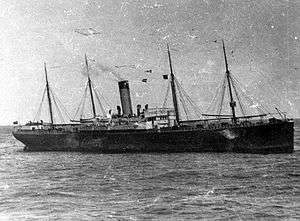
One of the most controversial issues examined by the inquiries was the role played by SS Californian, which had been only a few miles from Titanic but had not picked up her distress calls or responded to her signal rockets. Californian had warned Titanic by radio of the pack ice that was the reason Californian had stopped for the night, but was rebuked by Titanic's senior wireless operator, Jack Phillips.[189]
Testimony before the British inquiry revealed that at 10:10 p.m., Californian observed the lights of a ship to the south; it was later agreed between Captain Stanley Lord and Third Officer C.V. Groves (who had relieved Lord of duty at 11:10 p.m.) that this was a passenger liner.[189] At 11:50 p.m., the officer had watched that ship's lights flash out, as if she had shut down or turned sharply, and that the port light was now visible.[189] Morse light signals to the ship, upon Lord's order, were made between 11:30 p.m. and 1:00 a.m., but were not acknowledged.[190] If Titanic were as far from the Californian as Lord claimed, then he knew, or should have known, that Morse signals would not be visible. A reasonable and prudent course of action would have been to awaken the wireless operator and to instruct him to attempt to contact Titanic by that method. Had Lord done so, it is possible that he could have reached Titanic in time to save additional lives.[66]
Captain Lord had gone to the chartroom at 11:00 p.m. to spend the night;[191] however, Second Officer Herbert Stone, now on duty, notified Lord at 1:10 a.m. that the ship had fired five rockets. Lord wanted to know if they were company signals, that is, coloured flares used for identification. Stone said that he did not know and that the rockets were all white. Captain Lord instructed the crew to continue to signal the other vessel with the Morse lamp, and went back to sleep. Three more rockets were observed at 1:50 a.m. and Stone noted that the ship looked strange in the water, as if she were listing. At 2:15 a.m., Lord was notified that the ship could no longer be seen. Lord asked again if the lights had had any colours in them, and he was informed that they were all white.[192]
Californian eventually responded. At around 5:30 a.m., Chief Officer George Stewart awakened wireless operator Cyril Furmstone Evans, informed him that rockets had been seen during the night, and asked that he try to communicate with any ship. He got news of Titanic's loss, Captain Lord was notified, and the ship set out to render assistance. She arrived well after Carpathia had already picked up all the survivors.[193]
The inquiries found that the ship seen by Californian was in fact Titanic and that it would have been possible for Californian to come to her rescue; therefore, Captain Lord had acted improperly in failing to do so.[194][lower-alpha 17]
Survivors and victims
The number of casualties of the sinking is unclear, due to a number of factors. These include confusion over the passenger list, which included some names of people who cancelled their trip at the last minute, and the fact that several passengers travelled under aliases for various reasons and were therefore double-counted on the casualty lists.[196] The death toll has been put at between 1,490 and 1,635 people.[197] The tables below use figures from the British Board of Trade report on the disaster.[95]
Fewer than a third of those aboard Titanic survived the disaster. Some survivors died shortly afterwards; injuries and the effects of exposure caused the deaths of several of those brought aboard Carpathia.[198] The figures show stark differences in the survival rates of the different classes aboard Titanic. Although only 3% of first-class women were lost, 54% of those in third class died. Similarly, five of six first-class and all second-class children survived, but 52 of the 79 in third class perished. The differences by gender were even bigger: nearly all female crew members, first and second class passengers were saved. Men from the First Class died at a higher rate than women from the Third Class.[199]
The last living survivor, Millvina Dean from England, who at only nine weeks old was the youngest passenger on board, died aged 97 on 31 May 2009.[200] A special survivor was crew member Violet Jessop who survived the sinkings of both Titanic and Britannic and was aboard Olympic when she was rammed in 1911.[201]
| Age/ |
Class/ |
Number aboard | Number saved | Number lost | Percentage saved | Percentage lost |
|---|---|---|---|---|---|---|
| Children | First Class | 6 | 5 | 1 | 83% | 17% |
| Second Class | 24 | 24 | 0 | 100% | 0% | |
| Third Class | 79 | 27 | 52 | 34% | 66% | |
| Women | First Class | 144 | 140 | 4 | 97% | 3% |
| Second Class | 93 | 80 | 13 | 86% | 14% | |
| Third Class | 165 | 76 | 89 | 46% | 54% | |
| Crew | 23 | 20 | 3 | 87% | 13% | |
| Men | First Class | 175 | 57 | 118 | 33% | 67% |
| Second Class | 168 | 14 | 154 | 8% | 92% | |
| Third Class | 462 | 75 | 387 | 16% | 84% | |
| Crew | 885 | 192 | 693 | 22% | 78% | |
| Total | 2224 | 710 | 1514 | 32% | 68% | |
Retrieval and burial of the dead
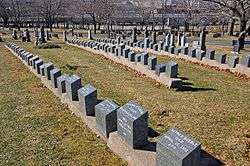
Once the massive loss of life became known, White Star Line chartered the cable ship CS Mackay-Bennett from Halifax, Nova Scotia, Canada, to retrieve bodies.[202] Three other Canadian ships followed in the search: the cable ship Minia,[203] lighthouse supply ship Montmagny and sealing vessel Algerine.[204] Each ship left with embalming supplies, undertakers, and clergy. Of the 333 victims that were eventually recovered, 328 were retrieved by the Canadian ships and five more by passing North Atlantic steamships.[205][lower-alpha 18]
The first ship to reach the site of the sinking, the CS Mackay-Bennett, found so many bodies that the embalming supplies aboard were quickly exhausted. Health regulations required that only embalmed bodies could be returned to port.[207] Captain Larnder of the Mackay-Bennett and undertakers aboard decided to preserve only the bodies of first class passengers, justifying their decision by the need to visually identify wealthy men to resolve any disputes over large estates. As a result, many third class passengers and crew were buried at sea. Larnder identified many of those buried at sea as crew members by their clothing, and stated that as a mariner, he himself would be contented to be buried at sea.[208]
Bodies recovered were preserved for transport to Halifax, the closest city to the sinking with direct rail and steamship connections. The Halifax coroner, John Henry Barnstead, developed a detailed system to identify bodies and safeguard personal possessions. Relatives from across North America came to identify and claim bodies. A large temporary morgue was set up in the curling rink of the Mayflower Curling Club and undertakers were called in from all across eastern Canada to assist.[208] Some bodies were shipped to be buried in their home towns across North America and Europe. About two-thirds of the bodies were identified. Unidentified victims were buried with simple numbers based on the order in which their bodies were discovered. The majority of recovered victims, 150 bodies, were buried in three Halifax cemeteries, the largest being Fairview Lawn Cemetery followed by the nearby Mount Olivet and Baron de Hirsch cemeteries.[209]
In mid-May 1912, RMS Oceanic recovered three bodies over 200 miles (320 km) from the site of the sinking who were among the original occupants of Collapsible A. When Fifth Officer Harold Lowe and six crewmen returned to the wreck site sometime after the sinking in a lifeboat to pick up survivors, they rescued a dozen males and one female from Collapsible A, but left the dead bodies of three of its occupants.[lower-alpha 19] After their retrieval from Collapsible A by Oceanic, the bodies were buried at sea.[210]
The last Titanic body recovered was steward James McGrady, Body No. 330, found by the chartered Newfoundland sealing vessel Algerine on 22 May and buried at Fairview Lawn Cemetery in Halifax on 12 June.[211]
Only 333 bodies of Titanic victims were recovered, one in five of the over 1500 victims. Some bodies sank with the ship while currents quickly dispersed bodies and wreckage across hundreds of miles making them difficult to recover. By June one of the last search ships reported that life jackets supporting bodies were coming apart and releasing bodies to sink.[212]
Wreck

Titanic was long thought to have sunk in one piece and, over the years, many schemes were put forward for raising the wreck. None came to fruition.[213] The fundamental problem was the sheer difficulty of finding and reaching a wreck that lies over 12,000 feet (3,700 m) below the surface, in a location where the water pressure is over 6,500 pounds per square inch.[214] A number of expeditions were mounted to find Titanic but it was not until 1 September 1985 that a Franco-American expedition led by Robert Ballard succeeded.[215][216]
The team discovered that Titanic had in fact split apart, probably near or at the surface, before sinking to the seabed. The separated bow and stern sections lie about a third of a mile (0.6 km) apart in a canyon on the continental shelf off the coast of Newfoundland. They are located 13.2 miles (21.2 km) from the inaccurate coordinates given by Titanic's radio operators on the night of her sinking,[217] and approximately 715 miles (1,151 km) from Halifax and 1,250 miles (2,012 km) from New York.
Both sections struck the sea bed at considerable speed, causing the bow to crumple and the stern to collapse entirely. The bow is by far the more intact section and still contains some surprisingly intact interiors. In contrast, the stern is completely wrecked; its decks have pancaked down on top of each other and much of the hull plating was torn off and lies scattered across the sea floor. The much greater level of damage to the stern is probably due to structural damage incurred during the sinking. Thus weakened, the remainder of the stern was flattened by the impact with the sea bed.[218]
The two sections are surrounded by a debris field measuring approximately 5 by 3 miles (8.0 km × 4.8 km).[219] It contains hundreds of thousands of items, such as pieces of the ship, furniture, dinnerware and personal items, which fell from the ship as she sank or were ejected when the bow and stern impacted on the sea floor.[220] The debris field was also the last resting place of a number of Titanic's victims. Most of the bodies and clothes were consumed by sea creatures and bacteria, leaving pairs of shoes and boots—which have proved to be inedible—as the only sign that bodies once lay there.[221]
Since its initial discovery, the wreck of Titanic has been revisited on numerous occasions by explorers, scientists, filmmakers, tourists and salvagers, who have recovered thousands of items from the debris field for conservation and public display. The ship's condition has deteriorated significantly over the years, particularly from accidental damage by submersibles but mostly because of an accelerating rate of growth of iron-eating bacteria on the hull.[222] It has been estimated that within the next 50 years the hull and structure of Titanic will eventually collapse entirely, leaving only the more durable interior fittings of the ship intermingled with a pile of rust on the sea floor.[223]
Many artefacts from Titanic have been recovered from the sea bed by RMS Titanic Inc., which exhibits them in touring exhibitions around the world and in a permanent exhibition at the Luxor Las Vegas hotel and casino in Las Vegas, Nevada.[224] A number of other museums exhibit artefacts either donated by survivors or retrieved from the floating bodies of victims of the disaster.[225]
On 16 April 2012, the day after the 100th anniversary of the sinking, photos were released showing possible human remains resting on the ocean floor. The photos, taken by Robert Ballard during an expedition led by NOAA in 2004, show a boot and a coat close to Titanic's stern which experts called "compelling evidence" that it is the spot where somebody came to rest, and that human remains could be buried in the sediment beneath them.[226] The wreck of the Titanic falls under the scope of the 2001 UNESCO Convention on the Protection of the Underwater Cultural Heritage. This means that all states party to the convention will prohibit the pillaging, commercial exploitation, sale and dispersion of the wreck and its artefacts. Because of the location of the wreck in international waters and the lack of any exclusive jurisdiction over the wreckage area, the convention provides a state co-operation system, by which states inform each other of any potential activity concerning ancient shipwreck sites, like the Titanic, and co-operate to prevent unscientific or unethical interventions.[227][228][229]
Legacy
Safety
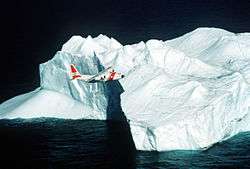
After the disaster, recommendations were made by both the British and American Boards of Inquiry stating that ships should carry enough lifeboats for all aboard, mandated lifeboat drills would be implemented, lifeboat inspections would be conducted, etc. Many of these recommendations were incorporated into the International Convention for the Safety of Life at Sea passed in 1914.[230] The convention has been updated by periodic amendments, with a completely new version adopted in 1974.[231] Signatories to the convention followed up with national legislation to implement the new standards. For example in Britain, new "Rules for Life Saving Appliances" were passed by the Board of Trade on 8 May 1914 and then applied at a meeting of British steamship companies in Liverpool in June 1914.[232]
Further, the United States government passed the Radio Act of 1912. This act, along with the International Convention for the Safety of Life at Sea, stated that radio communications on passenger ships would be operated 24 hours a day, along with a secondary power supply, so as not to miss distress calls. Also, the Radio Act of 1912 required ships to maintain contact with vessels in their vicinity as well as coastal onshore radio stations.[233] In addition, it was agreed in the International Convention for the Safety of Life at Sea that the firing of red rockets from a ship must be interpreted as a sign of need for help. Once the Radio Act of 1912 was passed it was agreed that rockets at sea would be interpreted as distress signals only, thus removing any possible misinterpretation from other ships.[233]
Finally, the disaster led to the formation and international funding of the International Ice Patrol, an agency of the United States Coast Guard that to the present day monitors and reports on the location of North Atlantic Ocean icebergs that could pose a threat to transatlantic sea traffic. Coast Guard aircraft conduct the primary reconnaissance. In addition, information is collected from ships operating in or passing through the ice area. Except for the years of the two World Wars, the International Ice Patrol has worked each season since 1913. During the period there has not been a single reported loss of life or property due to collision with an iceberg in the patrol area.[234] In 1912, the Board of Trade chartered the barque Scotia to act as a weather ship in the Grand Banks of Newfoundland, keeping a look-out for icebergs. A Marconi wireless was installed to enable her to communicate with stations on the coast of Labrador and Newfoundland.[235][236]
Cultural

Titanic has gone down in history as the ship that was called unsinkable.[lower-alpha 20] For more than 100 years, she has been the inspiration of fiction and non-fiction. She is commemorated by monuments for the dead and by museums exhibiting artefacts from the wreck. Just after the sinking memorial postcards sold in huge numbers[237] together with memorabilia ranging from tin candy boxes to plates, whiskey jiggers,[238] and even black mourning teddy bears.[239] Several survivors wrote books about their experiences[240] but it was not until 1955 the first historically accurate book A Night to Remember was published.[241]
The first film about the disaster, Saved from the Titanic, was released only 29 days after the ship sank and had an actual survivor as its star—the silent film actress Dorothy Gibson.[242] The British film A Night to Remember (1958) is still widely regarded as the most historically accurate movie portrayal of the sinking.[243] The most financially successful by far has been James Cameron's Titanic (1997), which became the highest-grossing film in history up to that time,[244] as well as the winner of 11 Oscars at the 70th Academy Awards, including Best Picture and Best Director for Cameron.[245]
The Titanic disaster was commemorated through a variety of memorials and monuments to the victims, erected in several English-speaking countries and in particular in cities that had suffered notable losses. These included Southampton, Liverpool and Belfast in the United Kingdom; New York and Washington, D.C. in the United States; and Cobh (formerly Queenstown) in Ireland.[246] A number of museums around the world have displays on Titanic. In Northern Ireland, the ship is commemorated by the Titanic Belfast visitor attraction, opened on 31 March 2012, that stands on the site of the shipyard where Titanic was built.[247]
RMS Titanic Inc., which is authorised to salvage the wreck site, has a permanent Titanic exhibition at the Luxor Las Vegas hotel and casino in Nevada which features a 22-ton slab of the ship's hull. It also runs an exhibition which travels around the world.[248] In Nova Scotia, Halifax's Maritime Museum of the Atlantic displays items that were recovered from the sea a few days after the disaster. They include pieces of woodwork such as panelling from the ship's First Class Lounge and an original deckchair,[249] as well as objects removed from the victims.[250] In 2012 the centenary was marked by plays, radio programmes, parades, exhibitions and special trips to the site of the sinking together with commemorative stamps and coins.[159][251][252][253][254]
In a frequently commented-on literary coincidence, Morgan Robertson authored a novel called Futility in 1898 about a fictional British passenger liner with the plot bearing a number of similarities to the Titanic disaster. In the novel the ship is the SS Titan, a four-stacked liner, the largest in the world and considered unsinkable. But like the Titanic, she sinks on her maiden voyage after hitting an iceberg and does not have enough lifeboats.[255]
Appendix

S: Sun deck. A: Upper promenade deck. B: Promenade deck, glass-enclosed. C: Saloon deck. E: Main deck. F: Middle deck. G: Lower deck: cargo, coal bunkers, boilers, engines. (a) Welin davits with lifeboats, (b) Bilge, (c) Double bottom
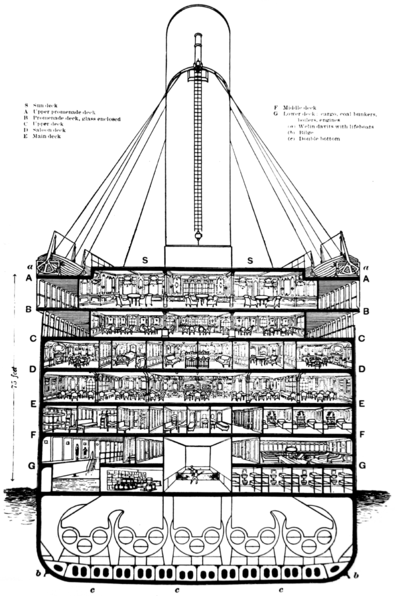

- 17 September 1908: Ship ordered.[256]
- 31 May 1911: Ship launched.[257]
- 1 April 1912: Trials completed.[258]
- 10 April, noon: Maiden voyage starts. Leaves Southampton dock, narrowly escaping collision with American liner New York.[258]
- 10 April, 19:00: Stops at Cherbourg for passengers.[258]
- 10 April, 21:00: Leaves Cherbourg for Queenstown.[258]
- 11 April, 12:30: Stops at Queenstown for passengers and mail.[258]
- 11 April, 14:00: Leaves Queenstown for New York.[258]
- 14 April, 23:40: Collision with iceberg (Latitude 41° 46′ N, Longitude 50° 14′ W).[259][lower-alpha 21]
- 15 April, 00:45: First boat, No. 7, lowered.[260][lower-alpha 21]
- 15 April, 02:05: Last boat, Collapsible D, lowered.[260][lower-alpha 21]
- 15 April, 02:20: Foundering.[260][lower-alpha 21]
- 15 April, 03:30–08:50: Rescue of survivors.[260][lower-alpha 21]
- 19 April – 25 May: US inquiry.[176]
- 2 May – 3 July: British inquiry.[262]
- 1 September 1985: Discovery of wreck.[215]
Titanic replicas
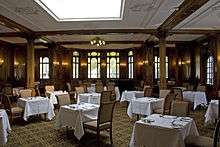
There have been several proposals and studies for a project to build a replica ship based on the Titanic. A project by South African businessman Sarel Gaus was abandoned in 2006, and a project by Australian businessman Clive Palmer was announced in 2012, known as the Titanic II. In late 2014 it was announced that the project has been abandoned due to low funding.
A Chinese firm named "Seven Star" commenced a project in January 2014 to build a replica of the Titanic for use as part of a water-front theme park. The ship will take on passengers and then, without actually leaving port, it will simulate being struck by an iceberg and sinking. The project has been criticised as being in "poor taste".[263]
The RMS Olympic was the sister ship of the Titanic. The interior decoration of the dining salon and the grand staircase were in identical style and created by the same craftsmen. Large parts of the interior of the Olympic were later sold and are now in the White Swan Hotel, Alnwick, which gives an impression of how the interior of the Titanic looked.
See also
- International Maritime Organization
- Lists of shipwrecks
- RMS Titanic alternative theories, alternative explanations for the fate of the Titanic (rather than it hitting an iceberg)
- Futility, or the Wreck of the Titan
- Audio tape interview by Lyle Bebensee of the last male survivor of the sinking of the Titanic, Bill Muller.

Notes
- ↑ Carlisle would leave the project in 1910, before the ships were launched, when he became a shareholder in Welin Davit & Engineering Company Ltd, the firm making the ship's davits.[12] Wilding was sacked following the Titanic disaster, having apparently been blamed by Pirrie, unfairly, for the ship's loss.[13]
- ↑ It was kept off-limits to passengers; the famous "flying" scene at the ship's bow from the 1997 film Titanic would not have been permitted in real life.
- ↑ This photo is probably of Titanic's sister ship, Olympic.[26]
- ↑ Copy after Merry-Joseph Blondel of the neoclassical oil painting[57]
- ↑ Measurement of lifeboats: 1–2: 25'2" long by 7'2" wide by 3'2" deep; 326.6 cubic feet (9.25 m3); 3–16: 30' long by 9'1" wide by 4' deep; 655.2 cubic feet (18.55 m3) and A–D: 27'5" long by 8' wide by 3' deep; 376.6 cubic feet (10.66 m3)
- ↑ Since 1894, when the largest passenger ship under consideration was the Cunard Line's 13,000-ton Lucania, the Board of Trade had made no provision to increase the existing scale regarding the number of required lifeboats for larger ships, such as the 46,000-ton Titanic. Sir Alfred Chalmers, nautical adviser to the Board of Trade from 1896 to 1911, had considered the matter of adjusting the scale "from time to time", but because he not only assumed that experienced sailors would need to be carried "uselessly" aboard ship only to lower and man the extra lifeboats, but also anticipated the difficulty in getting away a greater number than 16 boats in any emergency, he "did not consider it necessary to increase [the scale]".[65]
- ↑ He expressed deep disappointment about the decision before the voyage, but was presumably greatly relieved afterwards.[99]
- ↑ Titanic also had a ship's cat, Jenny, who gave birth to a litter of kittens shortly before the ship's maiden voyage; all perished in the sinking.[103]
- ↑ Known afterward as the "Unsinkable Molly Brown" due to her efforts in helping other passengers while the ship sank
- ↑ Captain Edward Smith had been in command of Titanic's sister Olympic when she in 1911 collided with a warship. Even though that ship was designed to sink others by ramming them, it suffered greater damage than Olympic, thereby strengthening the image of the class being unsinkable.[132][133]
- ↑ The official enquiry found that damage extended about 300 feet, but both Edward Wilding's testimony and modern ultrasound surveys of the wreck suggest the total area was perhaps a few narrow openings totalling perhaps no more than 12 to 13 square feet (1.1 to 1.2 m2).[136][72]
- ↑ An incident confirmed this philosophy while Titanic was under construction: the White Star liner Republic was involved in a collision and sank. Even though she did not have enough lifeboats for all passengers, they were all saved because the ship was able to stay afloat long enough for them to be ferried to ships coming to assist.[139]
- ↑ Life expectancy in such temperatures is often under 15 minutes even for people who are young and fit. The victims would have died from bodily reactions to freezing water rather than hypothermia (loss of core temperature). Immersed into freezing seas, around 20% of victims die within two minutes from cold shock (uncontrolled rapid breathing and gasping causing water inhalation, massive increase in blood pressure, cardiac strain leading to cardiac arrest, and panic), another 50% die within 15–30 minutes from cold incapacitation (inability to use or control limbs and hands for swimming or gripping, as the body 'protectively' shuts down peripheral muscles to protect its core),[146] and exhaustion and unconsciousness cause drowning, claiming the rest within a similar time.[147]
- ↑ The Salvation Army newspaper, The War Cry, reported that "none but a heart of stone would be unmoved in the presence of such anguish. Night and day that crowd of pale, anxious faces had been waiting patiently for the news that did not come. Nearly every one in the crowd had lost a relative."[161] It was not until 17 April that the first incomplete lists of survivors came through, delayed by poor communications.[162]
- ↑ On 23 April, the Daily Mail reported: "Late in the afternoon hope died out. The waiting crowds thinned, and silent men and women sought their homes. In the humbler homes of Southampton there is scarcely a family who has not lost a relative or friend. Children returning from school appreciated something of tragedy, and woeful little faces were turned to the darkened, fatherless homes."[169]
- ↑ According to an eyewitness report, there "were many pathetic scenes" when Titanic's survivors disembarked at New York
- ↑ Lord protested his innocence to the end of his life, and many researchers have asserted that the known positions of Titanic and Californian make it impossible that the former was the infamous "mystery ship", a topic which has "generated ... millions of words and ... hours of heated debates" and continues to do so.[195]
- ↑ Most of the bodies were numbered, however, the five passengers buried at sea by Carpathia went unnumbered.[206]
- ↑ Thomas Beattie, a first class passenger, and two crew members, a fireman and a seaman.
- ↑ An example is Daniel Butler's book about RMS Titanic, titled Unsinkable
- 1 2 3 4 5 Ship's time; at the time of the collision, Titanic's clocks were set to 2 hours 2 minutes ahead of Eastern Time Zone and 2 hours 58 minutes behind Greenwich Mean Time.[261]
References
- ↑ Beveridge & Hall 2004, p. 1.
- ↑ "Titanic Ship Listing". Chris' Cunard Page. Archived from the original on 15 April 2012. Retrieved 12 April 2012.
- ↑ Second Officer Lightoller insisted on excluding men, while First Officer Murdoch, on the other side of the ship, permitted men and women to board the lifeboats.
- ↑ "Patrick S. Ryan, The ITU and the Internet's Titanic Moment" (PDF). Retrieved 2014-07-04.
- ↑ Chirnside 2004, p. 319.
- ↑ Beveridge & Hall 2011, p. 27.
- ↑ Bartlett 2011, p. 26.
- ↑ "Outgoing Steamships – Sail Saturday October 26, 1912: Majestic (Southampton)". The Sun. October 24, 1912. Retrieved 18 May 2015.
- 1 2 Bartlett 2011, p. 25.
- 1 2 Hutchings & de Kerbrech 2011, p. 12.
- ↑ Hutchings & de Kerbrech 2011, p. 14.
- ↑ "Testimony of Alexander Carlisle". British Wreck Commissioner's Inquiry. 30 July 1912. Retrieved 8 November 2008.
- ↑ McCluskie 1998, p. 20.
- ↑ Eaton & Haas 1995, p. 55.
- 1 2 3 Eaton & Haas 1995, p. 56.
- 1 2 McCluskie 1998, p. 22.
- ↑ Chirnside 2004, p. efn319.
- 1 2 Hutchings & de Kerbrech 2011, p. 47.
- ↑ Gill 2010, p. 229.
- 1 2 3 4 5 6 7 Hutchings & de Kerbrech 2011, p. 48.
- ↑ Gill 2010, p. 232.
- ↑ Gill 2010, p. 233.
- ↑ Gill 2010, p. 235.
- 1 2 Gill 2010, p. 236.
- 1 2 Gill 2010, p. 237.
- ↑ Beveridge 2008, p. 100.
- ↑ Gill 2010, p. 120.
- 1 2 Gill 2010, p. 121.
- ↑ Hutchings & de Kerbrech 2011, p. 79.
- ↑ Hutchings & de Kerbrech 2011, p. 80.
- 1 2 Gill 2010, p. 126.
- 1 2 Gill 2010, p. 148.
- ↑ Hutchings & de Kerbrech 2011, p. 86.
- ↑ Hutchings & de Kerbrech 2011, p. 85.
- ↑ Hutchings & de Kerbrech 2011, p. 96.
- ↑ Gill 2010, p. 127.
- 1 2 Hutchings & de Kerbrech 2011, p. 74.
- ↑ Hutchings & de Kerbrech 2011, p. 106.
- ↑ Hutchings & de Kerbrech 2011, p. 107.
- 1 2 Hutchings & de Kerbrech 2011, p. 44.
- ↑ Gill 2010, p. 104.
- ↑ Hutchings & de Kerbrech 2011, p. 68.
- 1 2 Hutchings & de Kerbrech 2011, p. 70.
- 1 2 Gill 2010, p. 162.
- ↑ Bruce Beveridge et al., edited by Art Braunschweiger (2008). Titanic : the ship magnificent (3rd ed.). Stroud, Gloucestershire: History Press. ISBN 0752446061.
- ↑ Gill 2010, p. 165.
- 1 2 Hutchings & de Kerbrech 2011, p. 57.
- 1 2 Gill 2010, p. 182.
- ↑ Wels 1997, p. 34.
- ↑ "3rd Class General Room". National Museums Northern Ireland. 2011. Retrieved 28 May 2011.
- ↑ "1st Class Cafe Parisien". National Museums Northern Ireland. 2011. Retrieved 28 May 2011.
- ↑ Gill 2010, p. 189.
- 1 2 Hutchings & de Kerbrech 2011, p. 59.
- ↑ Lynch 1992, p. 53.
- ↑ Lynch 1992, p. 207.
- ↑ Merideth 2003, p. 236.
- 1 2 New York Times, Thursday January 16th, 1913, Titanic Survivors Asking $6,000,000, p.28
- 1 2 Gill 2010, p. 146.
- ↑ Eaton & Haas 1987, p. 131.
- ↑ The Titanic: The Memorabilia Collection, by Michael Swift, Igloo Publishing 2011, ISBN 978-0-85780-251-4
- 1 2 Hutchings & de Kerbrech 2011, p. 112.
- 1 2 Lord 1997, p. 78.
- ↑ Chirnside 2004, p. 26.
- ↑ Butler 1998, p. 38.
- ↑ "Board of Trade's Administration". British Wreck Commissioner's Inquiry. 30 July 1912. Retrieved 9 November 2008.
- 1 2 Berg, Chris (13 April 2012). "The Real Reason for the Tragedy of the Titanic". The Wall Street Journal.
- ↑ Gill 2010, p. 78.
- ↑ Hutchings & de Kerbrech 2011, p. 42.
- ↑ Hutchings & de Kerbrech 2011, p. 43.
- ↑ Gill 2010, p. 87.
- 1 2 Felkins, Leighly & Jankovic 1998.
- 1 2 Broad 1997.
- ↑ Materials Today, 2008.
- ↑ McCarty & Foecke 2012, p. .
- ↑ Broad 2008.
- ↑ Verhoeven 2007, p. 49.
- ↑ Smith, Jonathan. "Titanic: The Hingley Anchors".
- ↑ Gill 2010, p. 105.
- ↑ Gill 2010, p. 109.
- 1 2 3 Bartlett 2011, p. 33.
- 1 2 Hutchings & de Kerbrech 2011, p. 15.
- ↑ Hutchings & de Kerbrech 2011, p. 18.
- 1 2 3 Marriott, Leo (1997). TITANIC. PRC Publishing Ltd. ISBN 1-85648-433-5.
- ↑ Spignesi 1998, p. 22.
- ↑ Eaton & Haas 1995, p. 44.
- ↑ Eaton & Haas 1995, pp. 44, 46.
- ↑ Chirnside 2004, pp. 39–40.
- ↑ Eaton & Haas 1995, p. 45.
- ↑ Eaton & Haas 1995, p. 46.
- 1 2 McCluskie 1998, p. 21.
- ↑ Eaton and Haas; The Misadventures of the White Star Line, c.1990
- ↑ De Kerbrech, Richard, "Ships of the White Star Line", p. 50, 53, 112
- 1 2 3 Southampton–Cherbourg–New York Service, White Star Line leaflet of circa January 1912.
- ↑ "Southampton in 1912". Southampton City Council. Archived from the original on 22 January 2012. Retrieved 1 April 2012.
- 1 2 3 Mersey 1912, pp. 110–111.
- ↑ Barratt 2009, p. 84.
- ↑ Barratt 2009, p. 83.
- ↑ Bartlett 2011, pp. 43–44.
- 1 2 Gill 2010, p. 241.
- ↑ Barratt 2009, p. 92.
- ↑ Butler 1998, p. 238.
- 1 2 3 Gill 2010, p. 242.
- 1 2 Gill 2010, p. 246.
- ↑ Barratt 2009, p. 50.
- ↑ Barratt 2009, p. 93.
- 1 2 Howells 1999, p. 18.
- ↑ "Titanic Passenger List First Class Passengers". Encyclopedia Titanica. Retrieved 24 November 2008.
- ↑ Chernow 2010, Chapter 8.
- ↑ Brewster & Coulter 1998, p. 18.
- 1 2 Eaton & Haas 1995, p. 73.
- ↑ "Titanic—Passenger and Crew statistics". Historyonthenet.com. Retrieved 8 April 2012.
- ↑ Barratt 2009, p. 61.
- ↑ Gill 2010, p. 252.
- ↑ Eaton & Haas 1995, p. 76.
- ↑ Brewster & Coulter 1998, p. 22.
- ↑ Bartlett 2011, p. 71.
- 1 2 3 Halpern 2011, p. 79.
- ↑ Eaton & Haas 1995, p. 92.
- ↑ Eaton & Haas 1995, p. 93.
- 1 2 Eaton & Haas 1995, p. 100.
- ↑ Joseph J. Portanova. "Memory and Monuments: Some Sites Connected with the Titanic in Manhattan" (PDF). New York University. Retrieved 24 Aug 2015.
- ↑ John Lang (2012). Titanic: A Fresh Look at the Evidence by a Former Chief Inspector of Marine Accidents. Rowman & Littlefield Publishers. p. 124. ISBN 1442218924.
- ↑ Halpern 2011, p. 71.
- ↑ Halpern 2011, p. 75.
- ↑ Halpern 2011, p. 73.
- ↑ Halpern 2011, pp. 74–75.
- ↑ Halpern 2011, p. 80.
- ↑ Ryan 1985, p. 9.
- 1 2 Mowbray 1912, p. 278.
- ↑ Bartlett 2011, p. 24.
- ↑ Barczewski 2006, p. 13.
- ↑ "Titanic and co, RMS Olympic The Old Reliable". Titanicandco.com. Retrieved 2013-05-28.
- ↑ James Donahue (1911-09-20). "The Titanic's Sister Ship Olympic". Perdurabo10.tripod.com. Retrieved 2013-05-28.
- ↑ Lord 2005, p. 2.
- ↑ Barczewski 2006, p. 191.
- ↑ Report 1912, p. question 20422, Day 19.
- ↑ Ballard 1987, p. 22.
- ↑ Hutchings & de Kerbrech 2011, p. 116.
- ↑ Chirnside 2004, p. 29.
- ↑ Hutchings & de Kerbrech 2011, p. 109.
- ↑ Barczewski 2006, p. 21.
- 1 2 Barczewski 2006, p. 284.
- ↑ Halpern & Weeks 2011, p. 118.
- ↑ Ballard 1987, p. 204.
- ↑ Barczewski 2006, p. 29.
- ↑ "The Truth About The Cold Water". Mario Vittone. Retrieved 1 June 2014.
- ↑ "Hypothermia safety". United States Power Squadrons. January 23, 2007. Retrieved 2008-02-19.
- ↑ Aldridge 2008, p. 56.
- ↑ Lord 2005, p. 103.
- ↑ Brewster & Coulter 1998, pp. 45–47.
- ↑ Brewster & Coulter 1998, pp. 64–65.
- ↑ Bartlett 2011, p. 238.
- ↑ Bartlett 2011, pp. 242, 245.
- ↑ Bartlett 2011, p. 266.
- ↑ Bartlett 2011, p. 256.
- ↑ Butler 2002, p. 169.
- ↑ The Whatley Design Group, 2000 (15 April 1912). "A Walking Tour of Montreal – Sites Related to the Titanic Disaster". Vehiculepress.com. Retrieved 13 August 2012.
- ↑ Kerins, Dan (2012). "White Star Offices, Canute Chambers, Canute Road, Southampton". Titanic trail. Southern Daily Echo. Retrieved 21 March 2012.
- 1 2 "Titanic anniversary: the day Southampton went silent". The Telegraph. 5 April 2012.
- ↑ Butler 2002, p. 172.
- ↑ Bartlett 2011, p. 261.
- ↑ Bartlett 2011, p. 262.
- ↑ Butler 2002, pp. 170, 172.
- ↑ Landau 2001, pp. 22–23.
- ↑ Eaton & Haas 1995, p. 183.
- ↑ Eaton & Haas 1995, p. 184.
- ↑ Eaton & Haas 1995, p. 182.
- ↑ Eaton & Haas 1995, p. 204.
- ↑ Butler 1998, p. 173.
- ↑ Lloyd's. "Titanic Information Sheet" (PDF). Retrieved 16 February 2014.
- ↑ from Bing.com - Dave Manuel's Inflation Calculator Retrieved May 21, 2015
- ↑ The New York Times; Tuesday 30 April 1912 "GEORGE VANDERBILT'S ESCAPE.; Mrs. Dresser Persuaded Him Not to Sail on Titanic—Footman Lost". (in PDF format)
- ↑ Butler 1998, p. 174.
- ↑ Barczewski 2006, pp. 70–1.
- ↑ Brewster & Coulter 1998, p. 72.
- 1 2 "Titanic—The Senatorial Investigation". United States Senate Inquiry. Retrieved 19 June 2010.
- ↑ Butler 1998, pp. 180–186.
- ↑ Barczewski 2006, pp. 70–71, 182.
- ↑ Butler 1998, pp. 192–194.
- ↑ Butler 1998, p. 194.
- 1 2 Butler 1998, p. 195.
- ↑ Butler 1998, p. 189.
- ↑ Barczewski 2006, p. 67.
- 1 2 Lynch 1992, p. 189.
- ↑ Eaton & Haas 1995, p. 265.
- ↑ Eaton & Haas 1995, p. 223.
- ↑ Eaton & Haas 1995, p. 310.
- ↑ Court of Inquiry Loss of the S.S. Titanic 1912
- 1 2 3 Butler 2002, p. 160.
- ↑ Butler 2002, p. 161.
- ↑ Butler 2002, p. 159.
- ↑ Chirnside 2004, p. 344.
- ↑ Butler 2002, pp. 164–165.
- ↑ Butler 2002, pp. 191, 196.
- ↑ Paul Rogers. "The Titanic and the Indifferent Stranger". Encyclopedia-titanica.org. Retrieved 2013-05-28.
- ↑ Butler 1998, p. 239.
- ↑ Lord 1976, p. 197.
- ↑ Eaton & Haas 1994, p. 179.
- ↑ Howells 1999, p. 94.
- ↑ Last Titanic survivor, a baby put in a lifeboat, dies at 97 The Guardian. Retrieved 31 March 2012
- ↑ "Titanic and other White Star ships Titanic Crew Member Profile: Violet Constance Jessop, Ship Stewardess". Titanic-whitestarships.com. 1958-07-19. Retrieved 2013-05-28.
- ↑ Eaton & Haas 1995, p. 228.
- ↑ Eaton & Haas 1995, p. 232.
- ↑ Eaton & Haas 1995, p. 234.
- ↑ Eaton & Haas 1995, p. 225.
- ↑ "RMS Titanic: List of Bodies and Disposition of Same". Nova Scotia Archives and Records Management. Retrieved 3 March 2008.
- ↑ "Maritime Museum of the Atlantic Titanic Research Page—Victims". Museum.gov.ns.ca. 8 November 2010. Archived from the original on 7 December 2009. Retrieved 29 January 2011.
- 1 2 Mowbray, Jay Henry (1912). "Chapter xxi. the funeral ship and its dead". The sinking of the Titanic (1912). Retrieved 24 November 2008.
- ↑ Eaton & Haas 1995, pp. 244–245.
- ↑ Bartlett 2011, pp. 242–243.
- ↑ Alan Ruffman, Titanic Remembered: The Unsinkable Ship and Halifax Formac Publishing (1999), p. 38.
- ↑ "Why So Few?". Museum.gov.ns.ca. Archived from the original on 2013-01-25. Retrieved 2013-05-28.
- ↑ Ward 2012, p. 166.
- ↑ Spignesi 2012, p. 221.
- 1 2 Ward 2012, pp. 171–172.
- ↑ "Paper says Titanic discovered". The San Bernardino County Sun. 1 September 1985. p. 3 – via Newspapers.com.

- ↑ Halpern & Weeks 2011, pp. 126–127.
- ↑ Ballard 1987, p. 205.
- ↑ Canfield 8 March 2012.
- ↑ Ballard 1987, p. 203.
- ↑ Ballard 1987, p. 207.
- ↑ Ward 2012, p. 171.
- ↑ Crosbie & Mortimer 2006, p. last page (no page number specified).
- ↑ Spignesi 2012, p. 259.
- ↑ Ward 2012, pp. 248, 251.
- ↑ "Human remains pictured at Titanic shipwreck site". Herald Sun.
- ↑ "Titanic | United Nations Educational, Scientific and Cultural Organization". Unesco.org. Retrieved 2013-10-02.
- ↑ "Titanic's remains to come under Unesco's protection". 6 April 2012.
- ↑ Booth, Robert (6 April 2012). "Titanic wreck to be protected by UN maritime convention". The Guardian. p. 6.
- ↑ "Captainsvoyage-forum, lifeboat requirements". Captainsvoyage-forum.com. Retrieved 2013-05-28.
- ↑ International Convention for the Safety of Life at Sea (SOLAS). International Maritime Organization, 1974.
- ↑ Conlin, Dan (2013-04-15). "A Titanic Report that Changed History". Marinecurator.blogspot.ca. Retrieved 2013-05-28.
- 1 2 Minichiello,P.E., Ray. "TITANIC Tragedy Spawns Wireless Advancements". The Guglielmo Marconi Foundation, U.S.A., Inc. Retrieved 30 September 2016.
- ↑ "Navigation Center, Ice Patrol". Navcen.uscg.gov. Retrieved 2013-05-28.
- ↑ "The ice danger in the North Atlantic". The Times (40136). London. 15 February 1913. col C, p. 4.
- ↑ "45p SY Scotia". Mike Skidmore. Retrieved 17 July 2015.
- ↑ Eaton & Haas 1995, p. 327.
- ↑ Eaton & Haas 1995, pp. 329–330.
- ↑ Maniera 2003, p. 50.
- ↑ Rasor 2001, p. 77.
- ↑ Lord 2005, p. xii.
- ↑ Spignesi 2012, p. 267.
- ↑ Heyer 2012, p. 104.
- ↑ Parisi 1998, p. 223.
- ↑ The Oscars 2015 News, Blogs & Articles | Academy Awards â€" Oscars 2015
- ↑ Spignesi 2012, pp. 262–263.
- ↑ BBC News 31 March 2012.
- ↑ Ward 2012, p. 252.
- ↑ Ward 2012, p. 251.
- ↑ Spignesi 2012, p. 261.
- ↑ ITV: Titanic. Retrieved 13 January 2012
- ↑ Iceberg Right Ahead!—review The Guardian. Retrieved 1 April 2012
- ↑ "Cruise to mark Titanic centenary". BBC News. 15 April 2009.
- ↑ "Gibraltar Titanic stamps". Gibraltar-stamps.com. Retrieved 2013-05-28.
- ↑ "Titanic - Futility". Retrieved 15 October 2014.
- ↑ Beveridge, Bruce; Andrews, Scott; Hall, Steve; Klistorner, Daniel (2009). "Chapter 1: Inception & Construction Plans". In Braunschweiger, Art. Titanic: The Ship Magnificent. I. Gloucestershire, United Kingdom: History Press. ISBN 9780752446066. Retrieved 25 May 2011.
- ↑ "Launch of Titanic". National Museums Northern Ireland. 2011. Retrieved 30 May 2011.
- 1 2 3 4 5 6 Lord 2005, p. 148.
- ↑ Lord 2005, p. 149.
- 1 2 3 4 Lord 2005, p. 150.
- ↑ Halpern 2011, p. 78.
- ↑ "British Wreck Commissioner's Inquiry". British Wreck Commissioner's Inquiry Report. Titanic Inquiry Project. Retrieved 19 June 2010.
- ↑ "Chinese firm Seven Star to build full-size Titanic replica and sink it - BelfastTelegraph.co.uk".
Bibliography
Books:
- Aldridge, Rebecca (2008). The Sinking of the Titanic. New York: Infobase Publishing. ISBN 978-0-7910-9643-7.
- Ballard, Robert D. (1987). The Discovery of the Titanic. New York: Warner Books. ISBN 978-0-446-51385-2.
- Barczewski, Stephanie (2006). Titanic: A Night Remembered. London: Hambledon Continuum. ISBN 978-1-85285-500-0.
- Barratt, Nick (2009). Lost Voices From the Titanic: The Definitive Oral History. London: Random House. ISBN 978-1-84809-151-1.
- Bartlett, W. B. (2011). Titanic: 9 Hours to Hell, the Survivors' Story. Stroud, Gloucestershire: Amberley Publishing. ISBN 978-1-4456-0482-4.
- Beveridge, Bruce; Hall, Steve (2004). Olympic & Titanic: The Truth Behind the Conspiracy. Haverford, Pennsylvania: Infinity Publishing. ISBN 978-0-7414-1949-1.
- Beveridge, Bruce (2008). Titanic—The Ship Magnificent Volume One: Design & Construction. Stroud: The History Press. ISBN 978-0-7524-4606-6.
- Beveridge, Bruce; Hall, Steve (2011). "Description of the ship". In Halpern, Samuel. Report into the Loss of the SS Titanic: A Centennial Reappraisal. Stroud, UK: The History Press. ISBN 978-0-7524-6210-3.
- Brewster, Hugh; Coulter, Laurie (1998). 882½ Amazing Answers to your Questions about the Titanic. Madison Press Book. ISBN 978-0-590-18730-5.
- Butler, Daniel Allen (1998). Unsinkable: the full story of the RMS Titanic. Mechanicsburg, PA: Stackpole Books. ISBN 978-0-8117-1814-1.
- Butler, Daniel Allen (2002) [1998]. Unsinkable: the full story of the RMS Titanic. USA: Da Capo Press. ISBN 978-0-306-81110-4.
- Chernow, Ron (2010). The House of Morgan: An American Banking Dynasty and the Rise of Modern Finance. New York: Grove Press. ISBN 978-0-8021-4465-2.
- Chirnside, Mark (2004). The Olympic-Class Ships. Stroud, England: Tempus. ISBN 978-0-7524-2868-0.
- Crosbie, Duncan; Mortimer, Sheila (2006). Titanic: The Ship of Dreams. New York, NY: Orchard Books. ISBN 978-0-439-89995-6.
- Eaton, John P.; Haas, Charles A. (1987). Titanic: Destination Disaster: The Legends and the Reality. Wellingborough, UK: Patrick Stephens. ISBN 978-0-00-732164-3.
- Eaton, John P.; Haas, Charles A. (1994). Titanic: Triumph and Tragedy. Wellingborough, UK: Patrick Stephens. ISBN 978-1-85260-493-6.
- Eaton, John P.; Haas, Charles A. (1995). Titanic: Triumph and Tragedy. New York: W.W. Norton & Company. ISBN 978-0-393-03697-8.
- Eaton, John P.; Haas, Charles A. (1999). Titanic: A Journey Through Time. Sparkford, Somerset: Patrick Stephens. ISBN 978-1-85260-575-9.
- Gill, Anton (2010). Titanic : the real story of the construction of the world's most famous ship. Channel 4 Books. ISBN 978-1-905026-71-5.
- Halpern, Samuel (2011). "Account of the Ship's Journey Across the Atlantic". In Halpern, Samuel. Report into the Loss of the SS Titanic: A Centennial Reappraisal. Stroud, UK: The History Press. ISBN 978-0-7524-6210-3.
- Halpern, Samuel; Weeks, Charles (2011). "Description of the Damage to the Ship". In Halpern, Samuel. Report into the Loss of the SS Titanic: A Centennial Reappraisal. Stroud, UK: The History Press. ISBN 978-0-7524-6210-3.
- Heyer, Paul (2012). Titanic Century: Media, Myth, and the Making of a Cultural Icon. Santa Barbara, CA: ABC-CLIO. ISBN 978-0-313-39815-5.
- Howells, Richard (1999). The Myth of the Titanic. United Kingdom: MacMillan Press. ISBN 978-0-333-72597-9.
- Hutchings, David F.; de Kerbrech, Richard P. (2011). RMS Titanic 1909–12 (Olympic Class): Owners' Workshop Manual. Sparkford, Yeovil: Haynes. ISBN 978-1-84425-662-4.
- Landau, Elaine (2001). Heroine of the Titanic: The Real Unsinkable Molly Brown. New York. pp. 22–23. ISBN 978-0-395-93912-3.
- Lord, Walter (1976). A Night to Remember. London: Penguin Books. ISBN 978-0-14-004757-8.
- Lord, Walter (1997) [1955]. A Night to Remember (3rd ed.). New York: Henry Holt and Company. ISBN 978-0-553-27827-9.
- Lord, Walter (2005) [1955]. A Night to Remember. New York: St. Martin's Griffin. ISBN 978-0-8050-7764-3.
- Lynch, Don (1992). Titanic: An Illustrated History. New York: Hyperion. ISBN 978-1-56282-918-6.
- Maniera, Leyla (2003). Christie's Century of Teddy Bears. London: Pavilion. ISBN 978-1-86205-595-7.
- McCarty, Jennifer Hooper; Foecke, Tim (2012) [2008]. What Really Sank The Titanic – New Forensic Evidence. New York: Citadel. ISBN 978-0-8065-2895-3.
- McCluskie, Tom (1998). Anatomy of the Titanic. London: PRC Publishing. ISBN 978-1-85648-482-4.
- Merideth, Lee W. (2003). 1912 Facts About Titanic. Sunnyvale, CA: Rocklin Press. ISBN 978-0-9626237-9-0.
- Mowbray, Jay Henry (1912). Sinking of the Titanic. Harrisburg, PA: The Minter Company. OCLC 9176732.
- Parisi, Paula (1998). Titanic and the Making of James Cameron. New York: Newmarket Press. ISBN 978-1-55704-364-1.
- Rasor, Eugene L. (2001). The Titanic: historiography and annotated bibliography. Westport, CT: Greenwood Publishing Group. ISBN 978-0-313-31215-1.
- Reade, Leslie (1993). The Ship That Stood Still: The Californian and Her Mysterious Role in the Titanic Disaster. Edited by Edward de Groot. New York and London: W. W. Norton & Company. ISBN 9780393035377.
- Spignesi, Stephen J. (1998). The Complete Titanic: From the Ship's Earliest Blueprints to the Epic Film. Secaucus, New Jersey: Birch Lane Press. ISBN 978-1-55972-483-8.
- Spignesi, Stephen J. (2012). The Titanic For Dummies. Hoboken, NJ: John Wiley & Sons. ISBN 978-1-118-20651-5.
- Verhoeven, John D. (2007). Steel Metallurgy for the Non-Metallurgist. Materials Park, OH: ASM International. ISBN 978-0-87170-858-8.
- Ward, Greg (2012). The Rough Guide to the Titanic. London: Rough Guides Ltd. ISBN 978-1-4053-8699-9.
- Wels, Susan (1997). Titanic: Legacy of the World's Greatest Ocean Liner. Del Mar, California: Tehabi Books. ISBN 978-0-7835-5261-3.
Journals and news articles:
- Broad, William J. (8 April 1997). "Toppling Theories, Scientists Find 6 Slits, Not Big Gash, Sank Titanic". The New York Times. Retrieved 5 November 2011.
- Broad, William J. (15 April 2008). "In Weak Rivets, a Possible Key to Titanic's Doom". The New York Times. Retrieved 13 March 2012.
- Canfield, Clarke (8 March 2012). "Full Titanic site mapped for 1st time". The Associated Press. Retrieved 9 March 2012.
- Felkins, Katherine; Leighly, HP; Jankovic, A (1998), "The Royal Mail Ship Titanic: Did a Metallurgical Failure Cause a Night to Remember?", JOM, Minerals, Metals & Materials Society, 50 (1): 12–18, doi:10.1007/s11837-998-0062-7
- Ryan, Paul R. (Winter 1985–1986). "The Titanic Tale". Oceanus. Woods Hole, MA: Woods Hole Oceanographic Institution. 4 (28).
- "New Titanic Belfast complex opens". BBC News. 31 March 2012. Retrieved 9 April 2012.
Investigations:
- "Report on the Loss of the "Titanic." (s.s.)". British Wreck Commissioner's Inquiry, Final Report (Watertight Compartments). 30 July 1912. Retrieved 14 April 2012.
- Mersey, Lord (1999) [1912]. The Loss of the Titanic, 1912. The Stationery Office. ISBN 978-0-11-702403-8.
External links
| Wikiquote has quotations related to: RMS Titanic |
| Wikimedia Commons has media related to RMS Titanic. |
| Wikimedia Commons has media related to Titanic (ship, 1912). |
| Wikisource has original text related to this article: |
| Wikivoyage has a travel guide for RMS Titanic. |
- RMS Titanic, Inc, exclusive steward of RMS Titanic
- Titanic Historical Society
- RMS Titanic at DMOZ
- RMS Titanic on Facebook
- Collection of Marconigram radio messages related to the Titanic
- "Titanic collected news and commentary". The Guardian.

- New York Times coverage of the Titanic
- RMS Titanic: 100 Years Later—An Online Newspaper Exhibition at Library of Virginia
- Titanic Footage and Survivors Interviews - YouTube
- Titanic Disaster - Genuine Footage 1911-1912 - British Pathe
- References to the Titanic in European Historic Newspapers
- Rare Postcard from the Titanic
Coordinates: 41°43′57″N 49°56′49″W / 41.73250°N 49.94694°W
